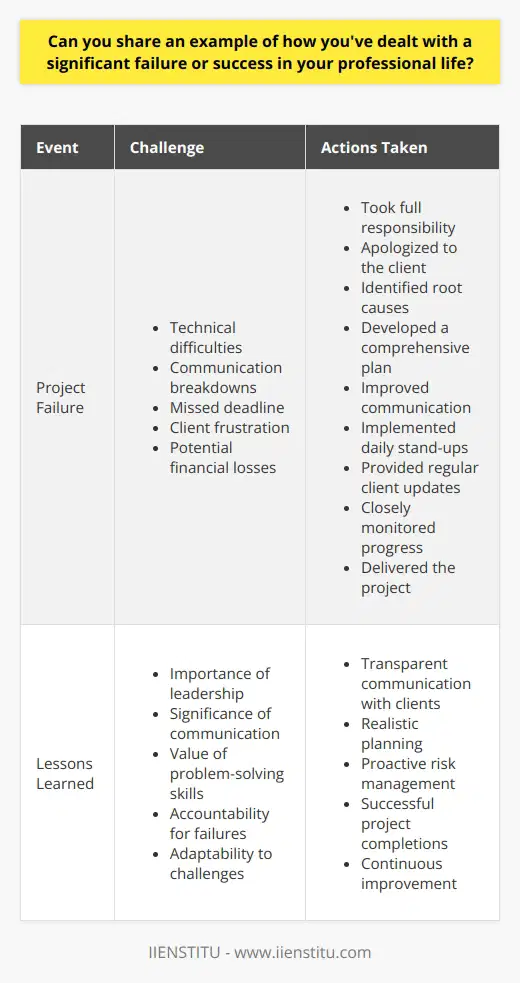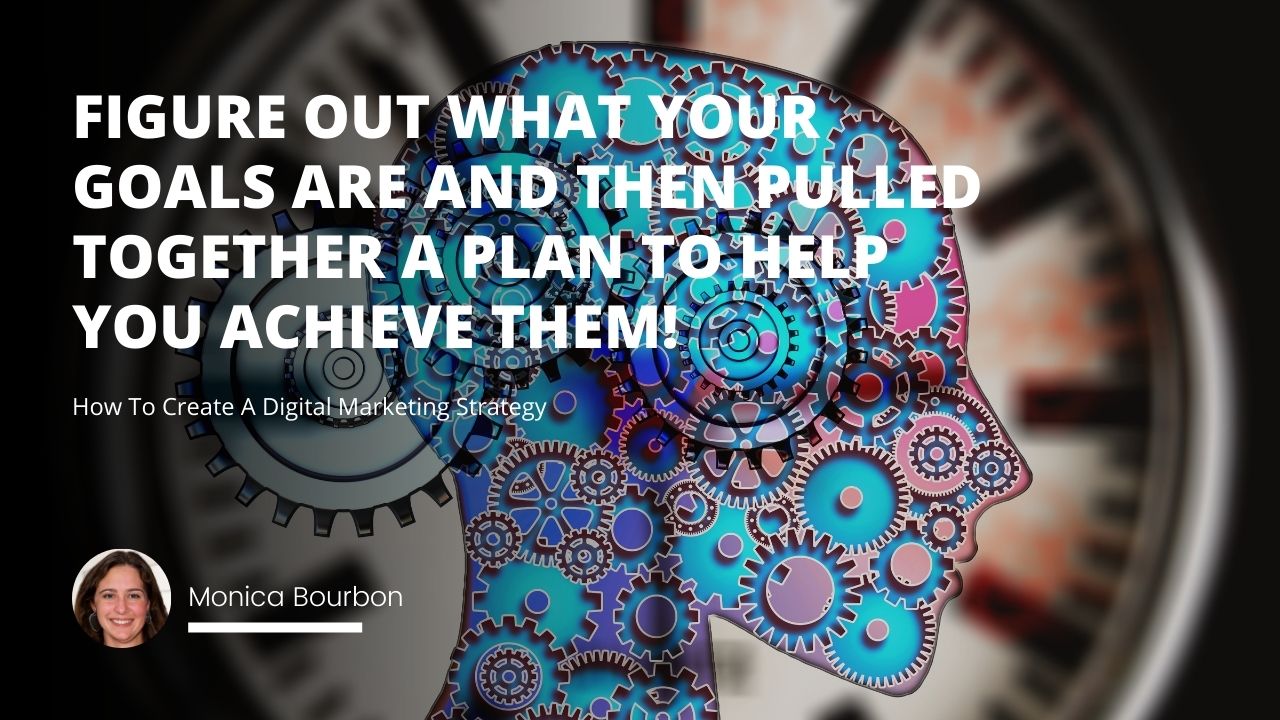
Digital marketing has become an integral part of businesses in today's digital age. It allows companies to reach a wider audience, increase brand visibility, and drive customer engagement. However, as with any marketing strategy, digital marketing is not foolproof, and failures can occur.
Related Course: Digital Marketing Online Course
These failures may range from a social media campaign that fell flat to a website that failed to generate leads. It's important for companies to have a plan in place to handle these digital marketing fails effectively.
Why is this interview question asked: How do you handle digital marketing fails?
One of the reasons why interviewers ask this question is to gauge the candidate's ability to handle setbacks and mistakes in a fast-paced and ever-evolving digital landscape. They want to assess how well the candidate can think on their feet, adapt to changes, and come up with innovative solutions in the face of failure.
This question also reveals a candidate's problem-solving skills, resilience, and ability to learn from past mistakes.
The purpose of the question
The purpose of this question is to assess a candidate's ability to handle digital marketing fails and their approach to problem-solving. Companies want to hire individuals who are resourceful, creative, and capable of turning failures into opportunities for growth.
By asking this question, interviewers are looking to understand how the candidate would handle and overcome digital marketing failures and what strategies they would implement to prevent similar mistakes in the future.
At what interview level is it asked?
This question can be asked at various levels of the interview process, ranging from entry-level positions to management roles. However, it is more likely to be posed to candidates applying for mid-level or senior digital marketing positions.
This is because individuals in these roles are expected to have a deeper understanding of digital marketing strategies and should be able to navigate and overcome failures with confidence.
What kind of answer is expected from the candidate?
When answering this question, the candidate should showcase their ability to analyze the failure, identify the factors that led to it, and propose actionable solutions. The candidate should demonstrate an understanding of different digital marketing channels and their intricacies.
Additionally, they should highlight their adaptability, willingness to learn from mistakes, and their capacity to turn failures into opportunities for improvement.
Possible answers to consider
Analyze and learn from the failure: The first step in handling digital marketing fails is to analyze the failure and understand the reasons behind it. This involves conducting a thorough review of the campaign or strategy, analyzing data and metrics, and identifying the areas that need improvement. By learning from the failure, you can avoid making the same mistakes in the future and refine your digital marketing approach.
Collaborate and seek input: Digital marketing involves a team effort, and it's essential to involve key stakeholders when handling failures. By collaborating with team members, you can gain different perspectives and insights that may help in identifying the root causes of the failure and generating innovative solutions. This fosters a culture of teamwork and collective problem-solving.
Communicate transparently with stakeholders: When a digital marketing campaign fails, it's crucial to communicate transparently with stakeholders, including clients, management, and team members. Being open and honest about the failure builds trust and allows for a more constructive dialogue. Explain the reasons behind the failure, present your analysis, and outline the steps being taken to rectify the situation. This demonstrates accountability and professionalism.
Experiment with new strategies: Digital marketing is a dynamic field, and what worked in the past may not yield the same results in the future. To handle digital marketing fails effectively, be open to experimenting with new strategies and tactics. Test different approaches, monitor performance, and adapt your tactics based on the data-driven insights. Embrace a culture of innovation and continuous improvement.
Focus on customer feedback and engagement: Digital marketing fails can provide valuable feedback from customers. Engage with your audience through surveys, social media listening, and customer feedback mechanisms to understand their perspective and preferences. Use this feedback to refine and tailor your future digital marketing efforts to better meet customer expectations.
Invest in ongoing education and professional development: Digital marketing is a rapidly evolving field, and staying updated with the latest trends, tools, and best practices is essential to avoid failures. Employers value candidates who prioritize their professional growth and invest in ongoing education. Demonstrate your commitment to continuous learning by highlighting relevant certifications, attending industry conferences, and actively seeking out new knowledge.
What to consider when answering
When answering this question, it is important to strike a balance between being honest about failures and showcasing your ability to handle them effectively. Emphasize your resilience, adaptability, and willingness to learn from mistakes. Draw on specific examples from your past experiences, highlighting how you turned failures into opportunities for growth and improvement. Showcase your problem-solving skills, your ability to analyze data and metrics, and your capacity to work collaboratively.
In conclusion, handling digital marketing fails requires a proactive and analytical approach. It is essential for candidates to demonstrate their ability to learn from failures, adapt their strategies, and foster a culture of continuous improvement. By showcasing their problem-solving skills, resilience, and willingness to learn, candidates can impress interviewers and position themselves as valuable assets in the ever-changing digital marketing landscape.
Types of digital marketing fails and their impacts
Strategies for handling digital marketing fails
Case studies of successful recovery from digital marketing fails
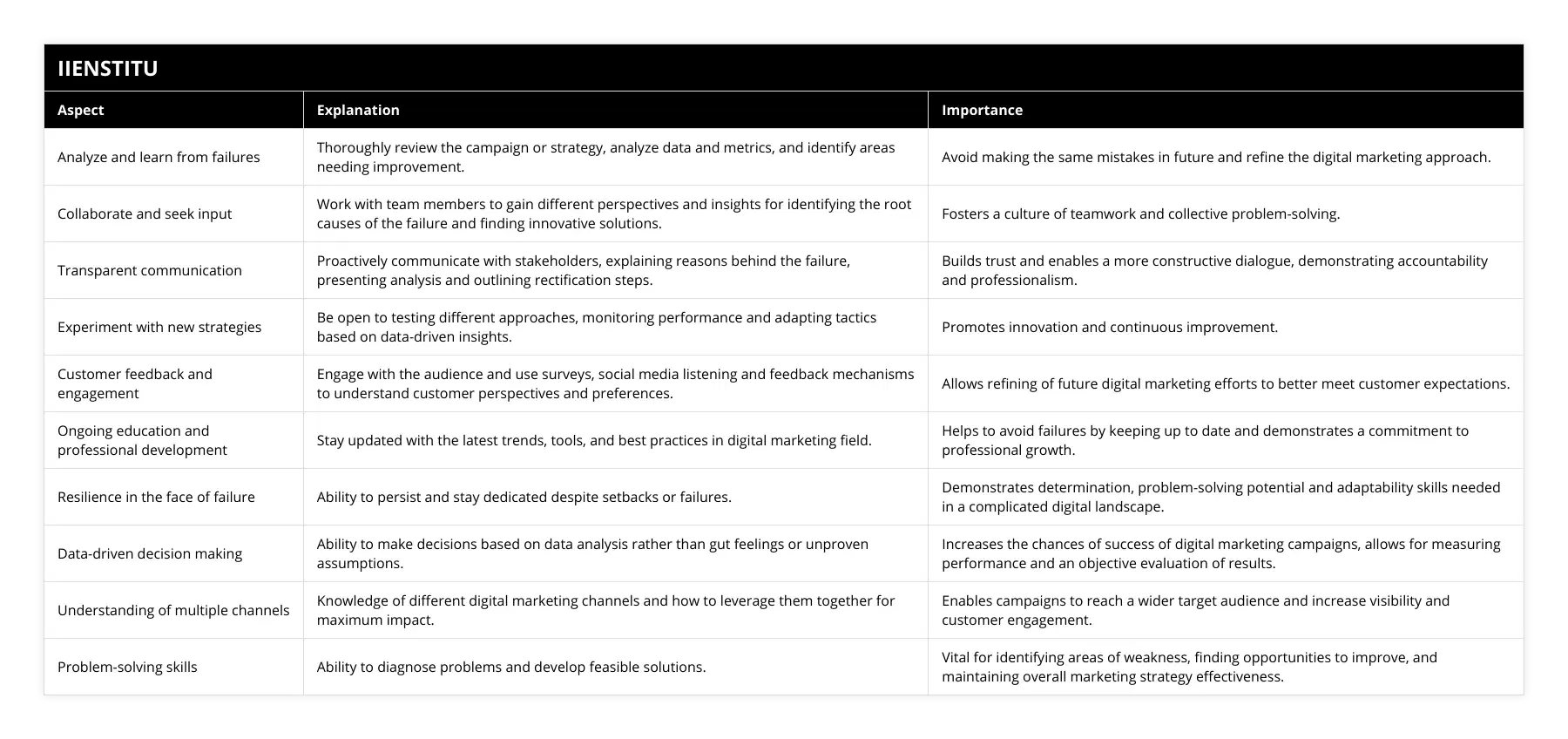
Frequently Asked Questions
How do you approach analyzing and learning from a failed digital marketing campaign?
Analyzing and learning from a failed digital marketing campaign requires a systematic and objective approach. The first step is to gather all relevant data, including metrics such as click-through rates, conversion rates, and engagement rates. This data should be compared to the campaign's goals and benchmarks to identify areas where the campaign fell short.
Identify Key Factors
Next, it's essential to identify the key factors that contributed to the campaign's failure. This may involve examining the campaign's messaging, targeting, and execution. Look for patterns or commonalities among the underperforming elements of the campaign. Consider factors such as the ad copy, visuals, and call-to-action.
Analyze Audience Engagement
Analyze audience engagement and behavior data to gain insights into how the target audience interacted with the campaign. Look for signs of confusion, disinterest, or frustration. Use tools like heat maps and user recordings to understand how users navigated the campaign's landing pages and identify potential barriers to conversion.
Conduct a Competitor Analysis
Conduct a competitor analysis to see how other brands in the same industry approached similar campaigns. Look for best practices and successful strategies that could be adapted for future campaigns. Analyze their messaging, targeting, and execution to identify potential areas for improvement.
Gather Feedback
Gather feedback from the team members involved in the campaign, as well as from the target audience. Conduct surveys or focus groups to gain insights into how the campaign was perceived and what could be improved. Use this feedback to inform future campaign planning and execution.
Develop an Action Plan
Finally, develop an action plan based on the insights gained from the analysis. Identify specific changes that can be made to improve future campaigns. This may involve adjusting the messaging, targeting, or execution of the campaign. Set clear goals and benchmarks for future campaigns, and establish a process for continuous monitoring and optimization.
Embrace Failure as a Learning Opportunity
Remember, failure is a natural part of the learning process. Embrace it as an opportunity to grow and improve. By analyzing and learning from failed campaigns, marketers can develop more effective strategies and tactics for future success.
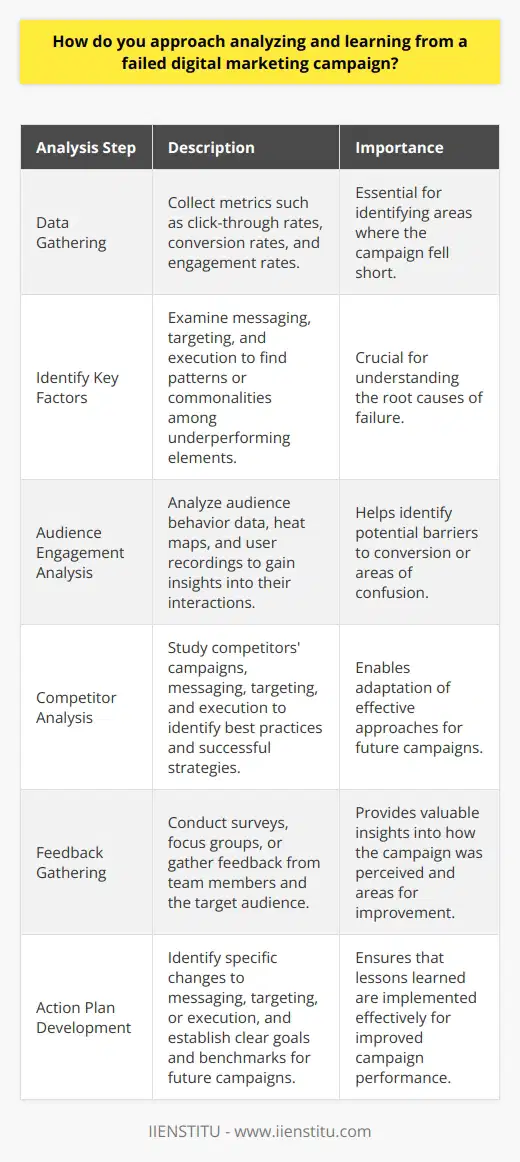
What strategies do you employ to minimize the risk of digital marketing failures?
To minimize the risk of digital marketing failures, employ a multifaceted approach that includes thorough research, strategic planning, and continuous optimization. Begin by conducting extensive market research to gain a deep understanding of your target audience, their preferences, and behaviors. This knowledge will guide your marketing decisions and help you create campaigns that resonate with your customers.
Develop a Comprehensive Marketing Strategy
Develop a comprehensive marketing strategy that aligns with your business goals and objectives. Set clear, measurable targets and define the key performance indicators (KPIs) you will use to track progress. Allocate resources wisely, prioritizing channels and tactics that have proven effective for your industry and target audience.
Embrace Data-Driven Decision Making
Embrace data-driven decision making by leveraging analytics tools to monitor campaign performance in real-time. Regularly review and analyze data to identify trends, patterns, and areas for improvement. Use these insights to make informed decisions, optimize your campaigns, and adjust your strategy as needed.
Foster a Culture of Continuous Testing and Optimization
Foster a culture of continuous testing and optimization within your marketing team. Encourage experimentation with different ad formats, messaging, and targeting options. Conduct A/B tests to determine which elements resonate best with your audience and drive the desired actions.
Invest in Quality Content and User Experience
Invest in creating high-quality, engaging content that provides value to your target audience. Ensure that your website and landing pages offer a seamless, intuitive user experience across all devices. Regularly update and refresh your content to keep it relevant and maintain visitor interest.
Monitor and Manage Your Online Reputation
Monitor and manage your online reputation by actively listening to customer feedback and engaging with your audience on social media. Address concerns and complaints promptly and professionally. Encourage satisfied customers to leave reviews and testimonials, as positive word-of-mouth can help build trust and credibility.
Stay Updated with Industry Trends and Best Practices
Stay updated with the latest industry trends, best practices, and emerging technologies. Attend workshops, webinars, and conferences to learn from experts and peers. Continuously educate yourself and your team to stay ahead of the curve and adapt to the ever-changing digital landscape.
By implementing these strategies and maintaining a proactive, data-driven approach, you can significantly reduce the risk of digital marketing failures and maximize your chances of success.
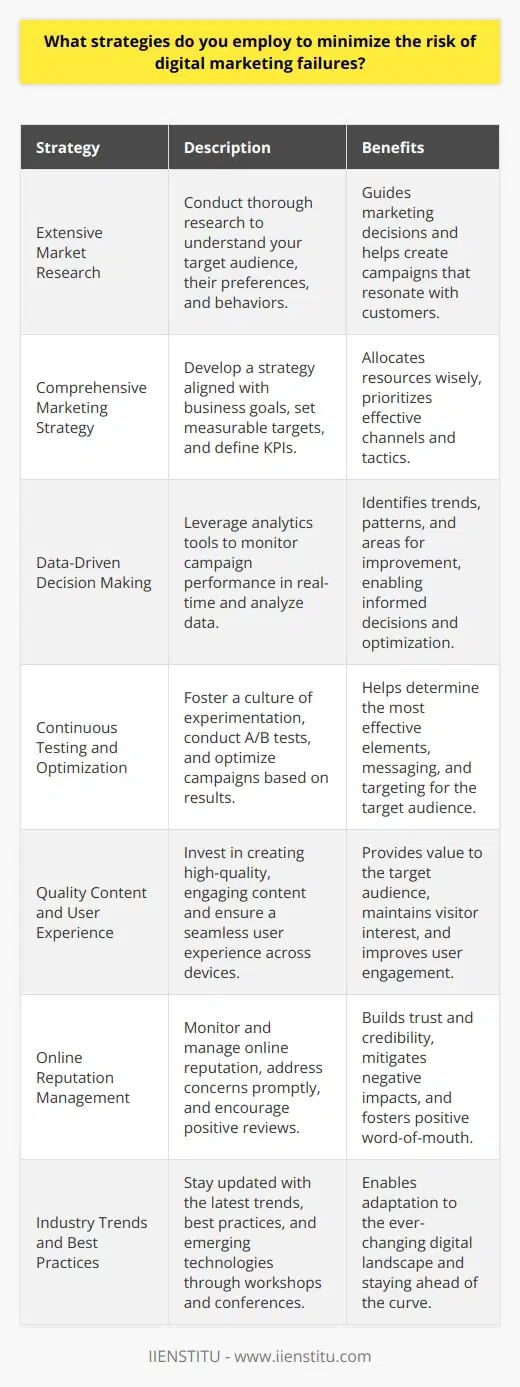
In the event of a digital marketing setback, how do you communicate with stakeholders and maintain their confidence in your abilities?
Effective communication is crucial when facing a digital marketing setback to maintain stakeholder confidence in your abilities. Transparency and honesty are key in addressing the issue head-on, acknowledging the setback and its potential impact. It's essential to provide a clear explanation of what happened, the steps being taken to rectify the situation, and the lessons learned to prevent future occurrences. Regular updates should be provided to keep stakeholders informed of progress and any changes in strategy.
Develop a Comprehensive Plan
To reassure stakeholders, present a well-thought-out plan that outlines the actions you will take to overcome the setback. This plan should include a thorough analysis of the problem, identifying the root causes and potential solutions. Demonstrate your expertise by proposing innovative strategies and tactics that align with the overall marketing objectives. Engage stakeholders in the process, seeking their input and feedback to foster a collaborative approach and build trust.
Emphasize Your Track Record
Remind stakeholders of your past successes and the value you have brought to the organization. Highlight your achievements, such as successful campaigns, increased brand awareness, or improved engagement metrics. By showcasing your proven track record, you reinforce your competence and reassure stakeholders that the setback is an isolated incident.
Focus on the Future
While addressing the setback is important, it's equally crucial to focus on the future. Communicate your vision for moving forward and the opportunities that lie ahead. Share your insights on industry trends and how you plan to capitalize on them to drive growth and success. By shifting the conversation to the future, you demonstrate your strategic thinking and ability to navigate challenges.
Maintain Open Lines of Communication
Ensure that you remain accessible and responsive to stakeholders throughout the process. Encourage open dialogue and be proactive in addressing any concerns or questions they may have. Regular check-ins and progress reports help maintain transparency and build confidence in your ability to handle the situation effectively.
Learn and Adapt
Treat the setback as an opportunity for growth and learning. Conduct a thorough post-mortem analysis to identify areas for improvement and implement necessary changes to prevent similar issues in the future. Communicate these learnings to stakeholders, demonstrating your commitment to continuous improvement and adaptability.
Conclusion
Effective communication is vital in managing a digital marketing setback and maintaining stakeholder confidence. By being transparent, developing a comprehensive plan, emphasizing your track record, focusing on the future, maintaining open lines of communication, and learning from the experience, you can navigate the challenges and emerge stronger. Remember, setbacks are opportunities for growth, and how you communicate during these times can significantly impact stakeholder perception and trust in your abilities.
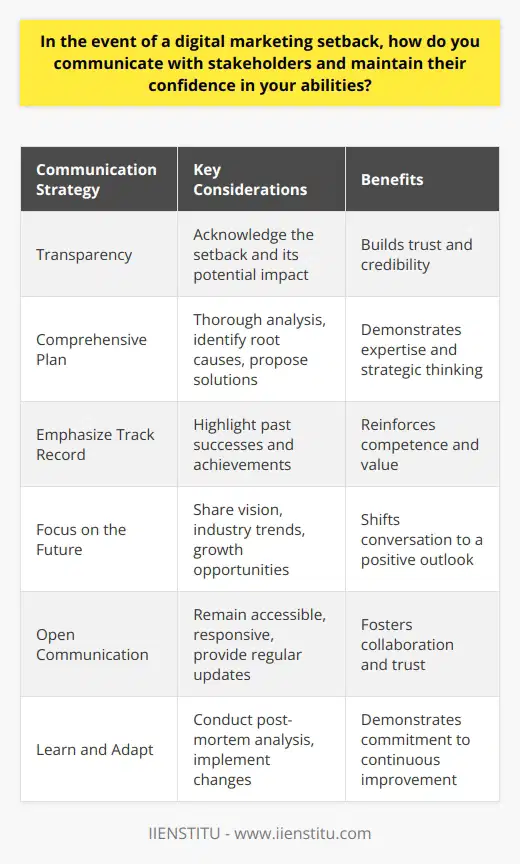
How do you handle a digital marketing campaign that fails to meet its objectives?
Handling a digital marketing campaign that fails to meet its objectives requires a systematic approach. The first step is to conduct a thorough analysis of the campaign's performance data. This includes examining metrics such as click-through rates, conversion rates, and engagement levels. By identifying the areas where the campaign fell short, marketers can pinpoint the root causes of the failure.
Reassess Target Audience and Messaging
One common reason for campaign failure is a misalignment between the target audience and the messaging. Marketers should revisit their buyer personas and ensure that the campaign's content resonates with their intended audience. This may involve conducting surveys, focus groups, or user testing to gather feedback and insights. Based on this information, marketers can adjust their messaging and creative assets to better appeal to their target audience.
Optimize Campaign Channels and Tactics
Another factor to consider is the effectiveness of the campaign's distribution channels and tactics. Marketers should evaluate the performance of each channel, such as social media, email, or paid advertising. They should also assess the impact of specific tactics, like A/B testing, retargeting, or influencer partnerships. By identifying the channels and tactics that yielded the best results, marketers can optimize their approach and allocate resources more effectively.
Collaborate with Cross-Functional Teams
Addressing campaign failures often requires collaboration with cross-functional teams, such as sales, product, or customer service. These teams can provide valuable insights into customer needs, pain points, and behavior. By working together, marketers can develop a more holistic understanding of their audience and create campaigns that better align with their goals.
Implement Agile Marketing Practices
To minimize the impact of campaign failures, marketers should adopt agile marketing practices. This involves setting shorter campaign cycles, regularly monitoring performance, and making data-driven adjustments in real-time. By embracing a more flexible and iterative approach, marketers can quickly identify and address issues before they escalate.
Conduct Post-Campaign Analysis and Learning
After the campaign concludes, marketers should conduct a comprehensive post-campaign analysis. This involves reviewing the campaign's successes, failures, and lessons learned. By documenting these insights and sharing them with the broader marketing team, organizations can continuously improve their digital marketing efforts and avoid repeating past mistakes.
Embrace Failure as an Opportunity for Growth
Ultimately, handling a failed digital marketing campaign requires a growth mindset. Marketers should view failures as opportunities to learn, innovate, and adapt. By embracing experimentation and calculated risk-taking, marketers can push the boundaries of what's possible and drive better results over time.
In conclusion, handling a digital marketing campaign that fails to meet its objectives requires a data-driven, audience-centric, and agile approach. By reassessing targeting and messaging, optimizing channels and tactics, collaborating with cross-functional teams, implementing agile practices, conducting post-campaign analysis, and embracing failure as an opportunity for growth, marketers can turn campaign failures into valuable learning experiences that inform future success.
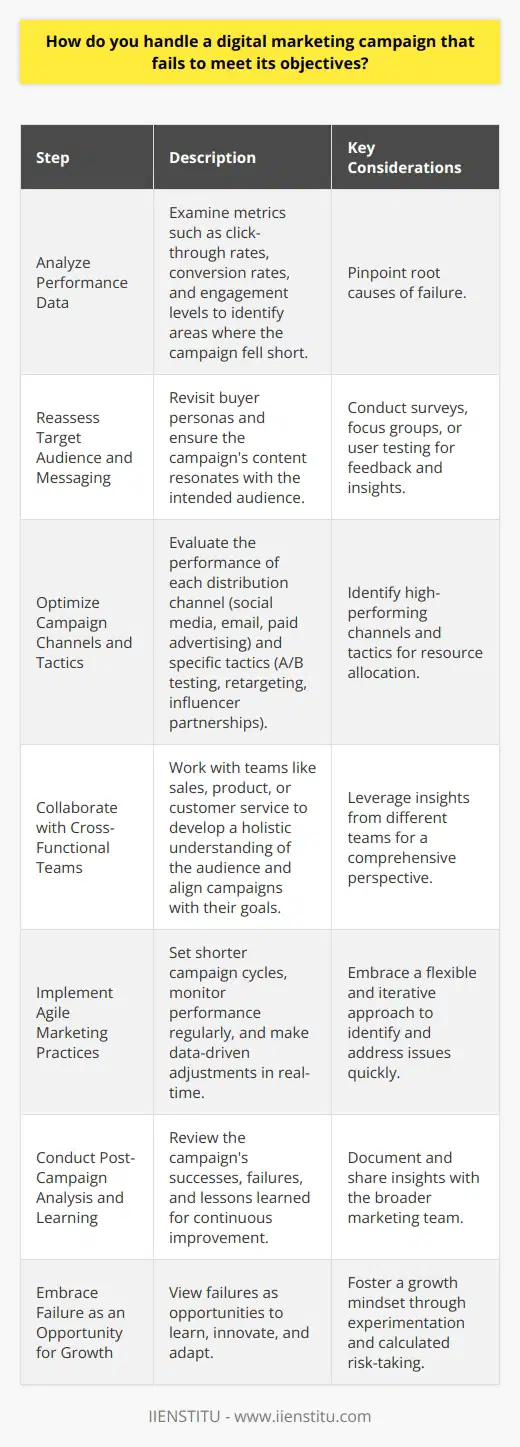
What strategies would you employ to recover from a failed digital marketing initiative?
Recovering from a failed digital marketing initiative requires a systematic approach that involves analyzing the cause of the failure, making necessary adjustments, and implementing new strategies. The first step is to conduct a thorough post-mortem analysis to identify the reasons behind the campaign's poor performance. This may involve examining metrics such as website traffic, conversion rates, and engagement levels to pinpoint areas where the campaign fell short.
Reassess Target Audience and Messaging
Based on the findings of the post-mortem analysis, it is crucial to reassess the target audience and messaging. Ensure that the marketing messages resonate with the intended audience and align with their needs and preferences. Conduct market research to gain a deeper understanding of the target audience's behavior, interests, and pain points. Use this information to refine the messaging and create content that addresses their specific concerns and provides value.
Optimize Campaign Elements
Review and optimize various elements of the digital marketing campaign to improve its effectiveness. This may include refining the ad copy, visuals, and call-to-action to make them more compelling and engaging. Test different variations of these elements through A/B testing to determine which versions resonate best with the target audience. Additionally, ensure that the campaign's landing pages are optimized for conversion, with clear and concise information, easy navigation, and a streamlined user experience.
Leverage Data and Analytics
Harness the power of data and analytics to make informed decisions and optimize the campaign's performance. Use tools like Google Analytics to track website traffic, user behavior, and conversion rates. Analyze the data to identify patterns, trends, and areas for improvement. Use this information to make data-driven decisions and adjust the campaign strategy accordingly. Continuously monitor the campaign's performance and make iterative changes based on the insights gained from the data.
Explore Alternative Channels and Tactics
Consider diversifying the marketing mix by exploring alternative channels and tactics. If the initial campaign relied heavily on one platform, such as Facebook ads, consider expanding to other channels like Google Ads, LinkedIn, or influencer marketing. Each platform has its unique audience and features, and diversifying the marketing efforts can help reach a wider audience and mitigate the risk of relying on a single channel.
Collaborate with Influencers and Partners
Collaborate with influencers and strategic partners to amplify the reach and credibility of the marketing campaign. Identify influencers who align with the brand's values and have a strong following within the target audience. Engage them to create authentic and compelling content that promotes the brand's message. Additionally, seek out strategic partnerships with complementary brands or organizations to cross-promote and leverage each other's audiences.
Continuously Test and Iterate
Embrace a culture of continuous testing and iteration to improve the campaign's performance over time. Conduct regular experiments to test different hypotheses and identify what works best for the target audience. This may involve testing different ad formats, messaging, targeting options, or landing page designs. Use the insights gained from these experiments to refine the campaign strategy and optimize for better results.
Stay Agile and Adaptable
In the fast-paced world of digital marketing, it is essential to stay agile and adaptable. Be prepared to pivot the campaign strategy based on changing market conditions, audience preferences, or emerging trends. Continuously monitor the competitive landscape and stay up-to-date with the latest industry developments to stay ahead of the curve.
By employing these strategies and maintaining a data-driven, customer-centric approach, businesses can recover from a failed digital marketing initiative and implement a more effective campaign that drives results and achieves the desired marketing objectives.

In the event of a digital marketing failure, how would you analyze the situation and propose solutions to prevent future setbacks?
In the event of a digital marketing failure, a comprehensive analysis is essential to identify the root causes and develop effective solutions. The first step is to gather data from various sources, such as web analytics, social media metrics, and customer feedback. This data should be carefully examined to pinpoint the specific areas where the campaign fell short, such as low engagement rates, poor conversion rates, or high bounce rates.
Identifying the Problem
Once the data has been collected and analyzed, the next step is to identify the specific problems that led to the campaign's failure. This may involve looking at factors such as the targeting strategy, the content of the campaign, the timing of the campaign, and the overall user experience. It is important to be thorough in this analysis and to consider all possible factors that may have contributed to the failure.
Developing Solutions
Based on the identified problems, the next step is to develop solutions that can prevent future setbacks. This may involve making changes to the targeting strategy, improving the quality of the content, optimizing the timing of the campaign, or enhancing the user experience. It is important to prioritize the solutions based on their potential impact and feasibility.
Testing and Refining
Once the solutions have been developed, it is important to test them to ensure their effectiveness. This may involve running small-scale experiments or pilot programs to gather data and feedback. Based on the results of these tests, the solutions can be refined and optimized before being implemented on a larger scale.
Continuous Monitoring and Optimization
Finally, it is important to continuously monitor the performance of the digital marketing campaign and to make ongoing optimizations as needed. This may involve regularly reviewing data and metrics, gathering feedback from customers and stakeholders, and making adjustments based on the insights gained. By continuously monitoring and optimizing the campaign, it is possible to prevent future setbacks and ensure the long-term success of the digital marketing efforts.
In conclusion, analyzing a digital marketing failure requires a systematic approach that involves gathering data, identifying problems, developing solutions, testing and refining, and continuously monitoring and optimizing. By following this approach, it is possible to learn from past mistakes and prevent future setbacks, ultimately leading to more successful and effective digital marketing campaigns.
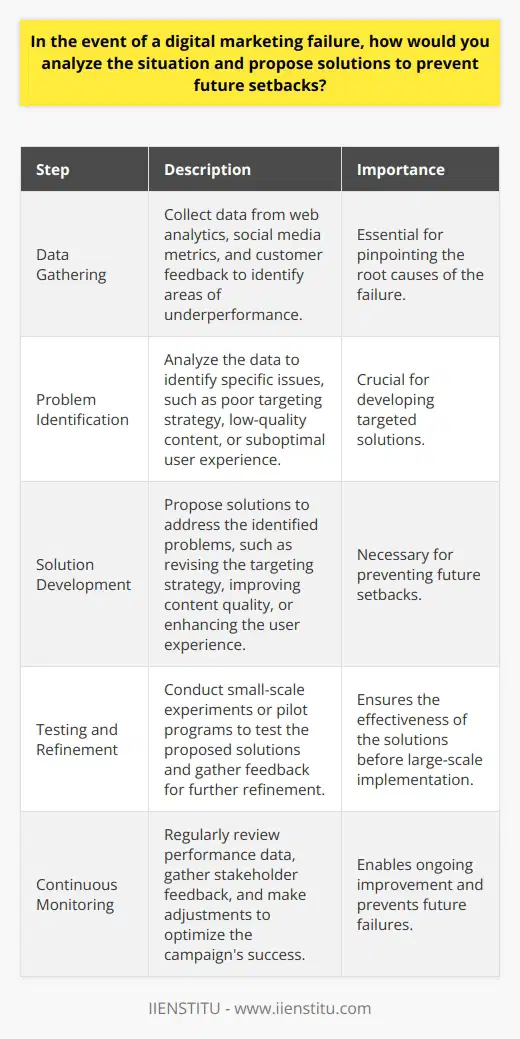
How do you handle failure in your professional life?
Handling failure in one's professional life is a crucial skill that can determine long-term success and growth. It requires a combination of resilience, self-reflection, and adaptability to overcome setbacks and learn from them. The first step in dealing with failure is to acknowledge and accept it, rather than denying or avoiding it. This allows for a more objective assessment of the situation and enables one to identify areas for improvement.
Embracing a Growth Mindset
Adopting a growth mindset is essential when facing failure in the professional realm. This means viewing setbacks as opportunities for learning and development, rather than as permanent reflections of one's abilities. By embracing challenges and seeing failure as a natural part of the learning process, individuals can cultivate a more resilient and adaptable approach to their work.
Learning from Failure
To effectively handle failure, it is crucial to engage in self-reflection and analysis. This involves examining the factors that contributed to the setback, such as inadequate preparation, miscommunication, or external circumstances. By identifying these factors, professionals can develop targeted strategies to address their weaknesses and prevent similar failures in the future.
Seeking Feedback and Support
Engaging with others is another key aspect of dealing with failure in the professional context. Seeking feedback from colleagues, mentors, or supervisors can provide valuable insights and perspectives on how to improve. Additionally, building a supportive network of peers who can offer encouragement and guidance during challenging times can help maintain motivation and confidence.
Developing Resilience
Resilience is a critical trait for professionals to cultivate when facing failure. This involves the ability to bounce back from setbacks and maintain a positive outlook in the face of adversity. Developing resilience requires practicing self-care, such as maintaining a healthy work-life balance, engaging in stress-reducing activities, and celebrating small successes along the way.
Moving Forward
Ultimately, handling failure in one's professional life is about using setbacks as stepping stones for growth and improvement. By embracing a growth mindset, learning from mistakes, seeking support, and developing resilience, professionals can turn failures into valuable learning experiences that contribute to their long-term success and development.
Implementing Lessons Learned
Once the lessons from a failure have been identified, it is important to put them into practice. This may involve adjusting work processes, developing new skills, or seeking additional training or resources. By actively implementing these changes, professionals can demonstrate their commitment to growth and improvement, and reduce the likelihood of experiencing similar setbacks in the future.
Celebrating Growth and Success
Finally, it is important to recognize and celebrate the growth and successes that come from effectively handling failure. This can include acknowledging the progress made in developing new skills, the successful completion of a challenging project, or the positive feedback received from colleagues or clients. By celebrating these achievements, professionals can maintain a positive outlook and build momentum for future success.
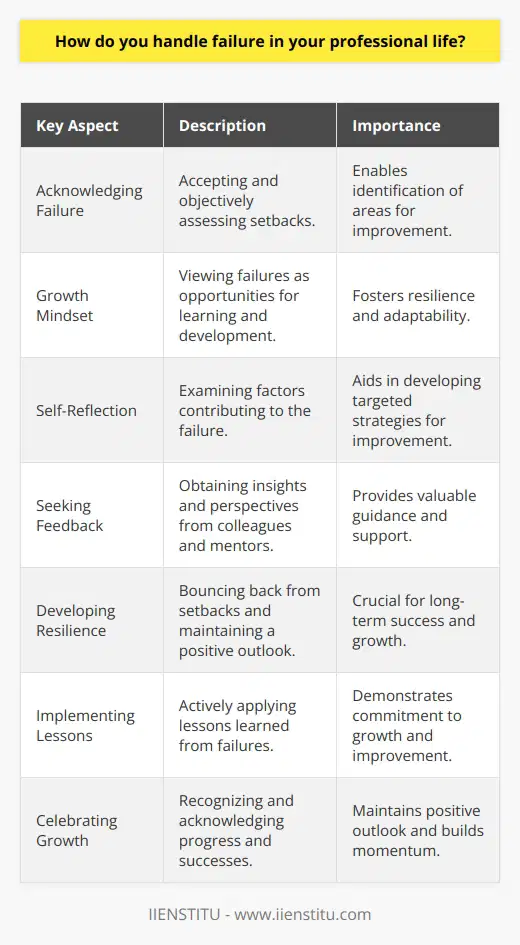
How do you typically respond when faced with failure?
When faced with failure, individuals often respond in various ways depending on their personality, mindset, and past experiences. Some may view failure as a devastating blow to their self-esteem, leading to feelings of shame, guilt, or despair. Others may perceive failure as a valuable learning opportunity, using it as a stepping stone to future success. Regardless of the initial emotional response, it is crucial to develop a healthy and constructive approach to dealing with failure.
Embracing a Growth Mindset
Adopting a growth mindset is essential when confronting failure. This perspective encourages individuals to view challenges and setbacks as opportunities for growth and development. By embracing the notion that abilities and intelligence can be enhanced through effort and dedication, one becomes more resilient in the face of failure. This mindset fosters a sense of determination and perseverance, enabling individuals to bounce back from disappointments and continue pursuing their goals.
Learning from Failure
Failure provides valuable lessons and insights that can contribute to personal and professional growth. By analyzing the factors that led to the failure, individuals can identify areas for improvement and develop strategies to prevent similar occurrences in the future. This reflective process allows for a deeper understanding of oneself, including strengths, weaknesses, and potential blind spots. By treating failure as a learning experience, individuals can acquire new knowledge, skills, and perspectives that will serve them well in future endeavors.
Maintaining a Positive Attitude
Maintaining a positive attitude in the face of failure is crucial for mental well-being and future success. Instead of dwelling on the negative aspects of the situation, it is important to focus on the potential for growth and improvement. This optimistic outlook helps individuals maintain motivation and confidence, even in challenging times. By reframing failure as a temporary setback rather than a permanent defeat, individuals can cultivate resilience and adaptability, enabling them to overcome obstacles and pursue their goals with renewed determination.
Seeking Support and Guidance
Surrounding oneself with a supportive network of family, friends, mentors, or colleagues can provide invaluable assistance when dealing with failure. These individuals can offer emotional support, encouragement, and valuable perspectives that can help reframe the situation in a more positive light. By seeking guidance from those who have experienced similar challenges, individuals can gain insights and strategies for overcoming obstacles and achieving success. Additionally, professional support, such as coaching or counseling, can provide targeted assistance in developing coping mechanisms and building resilience.
Taking Action and Moving Forward
While it is natural to experience a range of emotions following a failure, it is essential to avoid becoming stuck in a cycle of self-doubt or inaction. Instead, individuals should focus on taking proactive steps to address the situation and move forward. This may involve setting new goals, developing a plan of action, or seeking new opportunities. By taking control of the situation and actively working towards a solution, individuals can regain a sense of empowerment and purpose, helping them overcome the challenges posed by failure.
In conclusion, responding to failure in a healthy and constructive manner is crucial for personal and professional growth. By embracing a growth mindset, learning from mistakes, maintaining a positive attitude, seeking support, and taking action, individuals can transform failure into a valuable catalyst for success. By developing resilience and adaptability in the face of setbacks, one becomes better equipped to navigate the challenges of life and achieve their full potential.
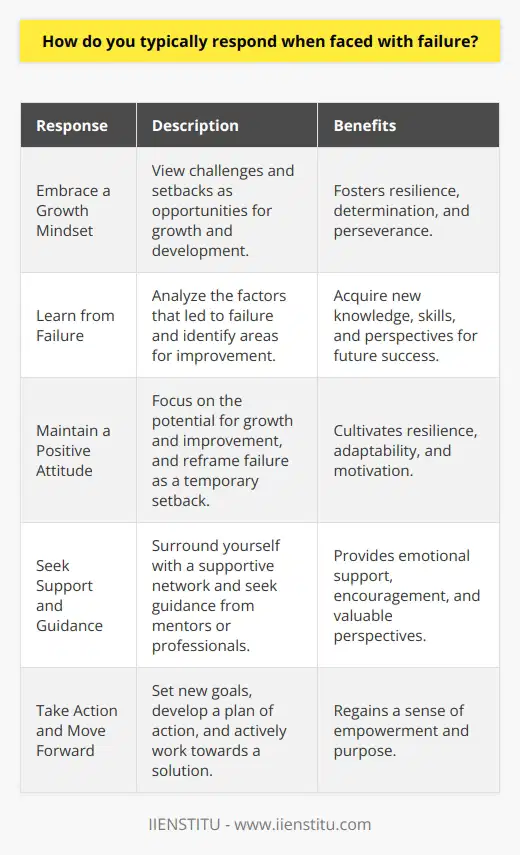
Can you provide an example of how you have handled failure in the past?
Handling failure is an essential skill for personal and professional growth. In my past experience, I encountered a significant setback during my senior year of college. I had invested countless hours in a research project, but the results were inconclusive and did not support my initial hypothesis.
Acknowledging the Failure
Initially, I felt discouraged and frustrated by the outcome of my research project. However, I quickly realized that dwelling on the failure would not help me move forward. Instead, I chose to acknowledge the setback and view it as an opportunity to learn and grow.
Analyzing the Situation
To better understand the reasons behind the failure, I carefully analyzed the research process. I identified areas where I could have improved my methodology and data collection techniques. This introspection helped me pinpoint the weaknesses in my approach and develop strategies to avoid similar mistakes in the future.
Seeking Feedback and Support
I sought guidance from my research advisor and other experienced professionals in my field. They provided valuable insights and suggestions on how to refine my research methods. Their support and encouragement helped me maintain a positive attitude and motivated me to persevere.
Developing a Plan of Action
Armed with new knowledge and insights, I developed a plan of action to move forward. I revised my research proposal, incorporating the lessons learned from my previous attempt. I set realistic goals and timelines, ensuring that I had a clear roadmap to follow.
Implementing the Plan and Adapting
As I embarked on my revised research project, I remained flexible and open to adapting my approach as needed. I regularly monitored my progress and made adjustments when necessary. This iterative process allowed me to refine my methods and improve the quality of my work.
Celebrating Small Victories
Throughout the process, I made a conscious effort to celebrate small victories along the way. Each milestone, no matter how small, served as a reminder of my progress and helped maintain my motivation. These victories also reinforced the importance of perseverance and resilience in the face of challenges.
Learning from the Experience
Ultimately, the experience of handling failure taught me valuable lessons that have served me well in my personal and professional life. I learned the importance of adaptability, resilience, and maintaining a growth mindset. I also discovered the value of seeking support and guidance from others when faced with setbacks.
Applying the Lessons Learned
Since that experience, I have applied the lessons learned to other challenges I have encountered. I approach setbacks with a more positive and proactive mindset, focusing on what I can learn and how I can grow from the experience. This attitude has helped me overcome obstacles and achieve success in various aspects of my life.
In conclusion, handling failure is a critical skill that requires acknowledging the setback, analyzing the situation, seeking support, developing a plan of action, and learning from the experience. By embracing failure as an opportunity for growth and applying the lessons learned, we can cultivate resilience and achieve our goals in the face of adversity.

What are some common digital marketing interview questions and their appropriate answers?
Digital marketing interviews often cover a range of topics, from basic concepts to more advanced strategies and techniques. Some common questions include discussing the candidate's experience with various digital marketing channels, such as search engine optimization (SEO), pay-per-click (PPC) advertising, social media marketing, and email marketing. Interviewers may also ask about the candidate's familiarity with analytics tools, such as Google Analytics, and their ability to interpret data to make informed decisions.
Understanding of Digital Marketing Fundamentals
When asked about digital marketing fundamentals, candidates should demonstrate a solid understanding of the core concepts and terminology. This includes explaining the difference between organic and paid search, the importance of keyword research, and the role of content marketing in driving website traffic and engagement. Candidates should also be able to discuss the benefits of various social media platforms and how they can be used to reach and engage with target audiences.
Experience with Specific Digital Marketing Channels
Interviewers may ask candidates to provide examples of their experience with specific digital marketing channels. For SEO, candidates should be able to discuss their approach to keyword research, on-page optimization, and link building. For PPC, they should be familiar with platforms like Google Ads and be able to explain how they would structure and optimize campaigns for maximum return on investment (ROI). When discussing social media marketing, candidates should showcase their knowledge of best practices for content creation, scheduling, and engagement across different platforms.
Data Analysis and Performance Metrics
Digital marketing professionals are expected to be data-driven and results-oriented. Interviewers may ask candidates to explain how they would measure the success of a digital marketing campaign and which key performance indicators (KPIs) they would track. Candidates should be comfortable discussing metrics such as click-through rates (CTR), conversion rates, bounce rates, and ROI. They should also be able to demonstrate their ability to use analytics tools to gather and interpret data, as well as make data-driven recommendations for optimizing campaigns.
Problem-Solving and Adaptability
Digital marketing is a constantly evolving field, and interviewers may present candidates with hypothetical scenarios to assess their problem-solving skills and adaptability. For example, they may ask how the candidate would respond to a sudden drop in website traffic or a negative social media comment. Strong candidates will be able to think on their feet and propose creative solutions that align with best practices and the overall goals of the organization.
Staying Up-to-Date with Industry Trends
Given the fast-paced nature of the digital marketing landscape, interviewers may also ask candidates how they stay informed about the latest industry trends and best practices. Candidates should be able to discuss their favorite industry blogs, podcasts, or conferences, as well as provide examples of how they have applied new knowledge or insights to their work.
Conclusion
Ultimately, the key to success in a digital marketing interview is to demonstrate a strong foundation in core concepts, the ability to think strategically and analytically, and a passion for staying at the forefront of industry trends. By preparing thoughtful responses to common questions and showcasing relevant experience and skills, candidates can increase their chances of impressing interviewers and landing their desired digital marketing role.

How can one prepare effectively for a digital marketing interview to showcase their skills and knowledge?
Preparing effectively for a digital marketing interview requires a comprehensive approach that showcases your skills and knowledge. Research the company and its digital marketing strategies to align your responses with their goals and values. Review common digital marketing interview questions and practice your answers to articulate your expertise confidently. Prepare examples of your successful digital marketing campaigns, highlighting your role and the achieved results.
Understand the Company and Its Digital Marketing Strategies
Before the interview, thoroughly research the company you are interviewing with to understand its products, services, and target audience. Visit their website, read their blog, and follow their social media channels to gain insights into their digital marketing approach. Identify their unique selling proposition and consider how you can contribute to their digital marketing efforts. Aligning your responses with the company's goals and values will demonstrate your genuine interest and suitability for the role.
Review Common Digital Marketing Interview Questions
Familiarize yourself with common digital marketing interview questions to prepare well-structured and compelling answers. Questions may cover topics such as SEO, PPC, social media marketing, content marketing, email marketing, and analytics. Practice articulating your knowledge and experience in each area, using industry terminology and citing relevant examples. Anticipate questions about your problem-solving abilities, creativity, and adaptability in the ever-evolving digital marketing landscape.
Highlight Your Successful Digital Marketing Campaigns
Prepare specific examples of digital marketing campaigns you have successfully executed in your previous roles. Choose campaigns that demonstrate your expertise in various digital marketing channels and showcase your ability to achieve measurable results. Be ready to discuss your role in the campaign, the strategies you employed, and the outcomes you achieved. Use data and metrics to quantify your success, such as increased website traffic, higher conversion rates, or improved ROI.
Demonstrate Your Analytical and Problem-Solving Skills
Digital marketing requires strong analytical and problem-solving skills to optimize campaigns and drive results. Prepare examples that highlight your ability to analyze data, identify trends, and make data-driven decisions. Discuss how you have used tools like Google Analytics, SEO software, or social media analytics to gather insights and improve campaign performance. Show your willingness to experiment, test hypotheses, and adapt strategies based on data-driven insights.
Showcase Your Creativity and Innovation
Digital marketing thrives on creativity and innovation. Prepare examples of how you have brought fresh ideas and innovative approaches to digital marketing campaigns. Discuss your ability to think outside the box, develop engaging content, and leverage emerging trends and technologies. Highlight your understanding of the target audience and how you have tailored campaigns to resonate with their preferences and behaviors.
Emphasize Your Continuous Learning and Adaptability
The digital marketing landscape is constantly evolving, with new platforms, technologies, and best practices emerging regularly. Demonstrate your commitment to continuous learning and staying up-to-date with industry trends. Discuss relevant certifications, workshops, or conferences you have attended to enhance your digital marketing skills. Showcase your adaptability by providing examples of how you have successfully navigated changes in algorithms, platform policies, or consumer behavior.
Practice Your Communication and Presentation Skills
Effective communication is crucial in digital marketing roles. Practice articulating your thoughts clearly and concisely during the interview. Use storytelling techniques to engage the interviewer and make your examples more memorable. Be prepared to present your portfolio or case studies in a professional and visually appealing manner. Demonstrate your ability to collaborate with cross-functional teams and communicate complex digital marketing concepts to non-technical stakeholders.
By following these strategies and showcasing your skills, knowledge, and experience, you can effectively prepare for a digital marketing interview and increase your chances of landing the role. Remember to project confidence, enthusiasm, and a genuine passion for digital marketing throughout the interview process.

What are the key areas of digital marketing that interviewers typically focus on during the question and answer process?
Interviewers typically focus on several key areas of digital marketing during the question and answer process. These areas include search engine optimization (SEO), pay-per-click (PPC) advertising, social media marketing, content marketing, and email marketing. Interviewers may also inquire about the candidate's experience with web analytics, conversion rate optimization (CRO), and mobile marketing.
Search Engine Optimization (SEO)
SEO is a crucial aspect of digital marketing that interviewers often emphasize. They may ask about the candidate's knowledge of keyword research, on-page optimization, link building, and technical SEO factors. Interviewers want to assess the candidate's ability to improve a website's visibility and rankings in search engine results pages (SERPs).
Pay-Per-Click (PPC) Advertising
PPC advertising is another important area that interviewers may focus on. They may inquire about the candidate's experience with platforms like Google Ads, Microsoft Ads, and social media advertising. Interviewers want to evaluate the candidate's ability to create, manage, and optimize PPC campaigns to drive targeted traffic and conversions.
Social Media Marketing
Interviewers may also concentrate on the candidate's social media marketing skills. They may ask about the candidate's experience with various social media platforms, such as Facebook, Instagram, Twitter, and LinkedIn. Interviewers want to assess the candidate's ability to develop and execute social media strategies that engage audiences, build brand awareness, and drive website traffic.
Content Marketing
Content marketing is another key area that interviewers may focus on. They may ask about the candidate's experience with creating and distributing valuable, relevant, and consistent content to attract and retain a clearly defined audience. Interviewers want to evaluate the candidate's ability to develop content strategies that align with business goals and drive user engagement.
Email Marketing
Interviewers may also inquire about the candidate's email marketing skills. They may ask about the candidate's experience with email campaign creation, segmentation, personalization, and automation. Interviewers want to assess the candidate's ability to develop and execute email marketing strategies that nurture leads, build customer loyalty, and drive conversions.
Web Analytics
Web analytics is another important area that interviewers may focus on. They may ask about the candidate's experience with tools like Google Analytics, Adobe Analytics, or other web analytics platforms. Interviewers want to evaluate the candidate's ability to collect, analyze, and interpret data to make data-driven decisions and optimize digital marketing efforts.
Conversion Rate Optimization (CRO)
Interviewers may also concentrate on the candidate's CRO skills. They may ask about the candidate's experience with A/B testing, user experience (UX) optimization, and landing page optimization. Interviewers want to assess the candidate's ability to improve website conversion rates and drive business growth.
Mobile Marketing
Mobile marketing is another key area that interviewers may focus on. They may ask about the candidate's experience with mobile-specific strategies, such as mobile app marketing, mobile-friendly website design, and SMS marketing. Interviewers want to evaluate the candidate's ability to reach and engage mobile audiences effectively.

How have you handled setbacks at work in the past?
Handling setbacks at work is an essential skill for professional growth and maintaining a positive work environment. When faced with challenges or obstacles, it's crucial to approach the situation with a constructive mindset and take proactive steps to overcome the setback.
Identifying the Root Cause
The first step in addressing a setback is to identify the root cause of the problem. Analyze the situation objectively and gather relevant information to understand the factors contributing to the setback. This process helps in developing an effective plan to tackle the issue head-on.
Conducting a SWOT Analysis
Conducting a SWOT (Strengths, Weaknesses, Opportunities, and Threats) analysis can provide valuable insights into the setback. Assess your strengths and weaknesses, and identify potential opportunities and threats. This analysis will help you prioritize your actions and allocate resources efficiently.
Developing a Plan of Action
Once you have identified the root cause and conducted a SWOT analysis, develop a plan of action. Break down the problem into smaller, manageable tasks and set realistic goals and timelines. Involve relevant stakeholders and collaborate with your team to ensure everyone is on the same page.
Setting SMART Goals
When setting goals to overcome the setback, make sure they are SMART (Specific, Measurable, Achievable, Relevant, and Time-bound). SMART goals provide clarity and direction, making it easier to track progress and make necessary adjustments along the way.
Maintaining a Positive Attitude
Maintaining a positive attitude is crucial when dealing with setbacks. Embrace the challenge as an opportunity for growth and learning. Encourage open communication within your team and foster a supportive work environment. Celebrate small wins and acknowledge the efforts of your colleagues.
Practicing Resilience
Resilience is the ability to bounce back from setbacks and adapt to change. Cultivate a resilient mindset by focusing on solutions rather than dwelling on problems. Learn from past experiences and apply those lessons to future challenges. Regularly engage in activities that promote mental and physical well-being to maintain a balanced perspective.
Seeking Support and Feedback
Don't hesitate to seek support and feedback from your colleagues, mentors, or supervisors. Collaborate with others to brainstorm ideas and explore alternative approaches. Actively seek feedback to identify areas for improvement and gain valuable insights from different perspectives.
Engaging in Continuous Learning
Embrace continuous learning as a means to overcome setbacks and enhance your skills. Attend workshops, seminars, or training programs relevant to your field. Stay updated with the latest industry trends and best practices. Continuously expanding your knowledge base will equip you with the tools needed to tackle future challenges effectively.
In conclusion, handling setbacks at work requires a proactive and positive approach. By identifying the root cause, developing a plan of action, maintaining a positive attitude, seeking support, and engaging in continuous learning, you can successfully navigate through challenges and emerge stronger and more resilient.
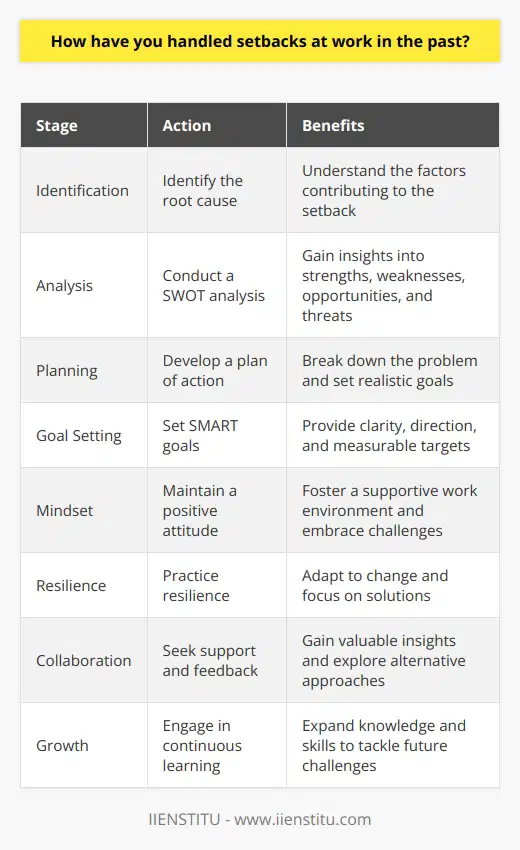
What strategies do you employ to overcome challenges and setbacks in your professional life?
In my professional life, I employ several strategies to overcome challenges and setbacks. Firstly, I maintain a positive attitude and view obstacles as opportunities for growth and learning. When faced with a difficult situation, I take a step back and assess the problem objectively, breaking it down into smaller, manageable components. This approach allows me to develop a clear action plan and tackle the issue systematically.
Seeking Support and Guidance
I recognize the importance of seeking support and guidance from colleagues, mentors, and supervisors when encountering professional challenges. By reaching out to others with more experience or expertise, I can gain valuable insights and perspectives that help me navigate difficult situations. Collaborating with team members also fosters a sense of shared responsibility and encourages creative problem-solving.
Continuous Learning and Skill Development
To overcome setbacks, I prioritize continuous learning and skill development. I actively seek out training opportunities, workshops, and courses that enhance my knowledge and abilities in my field. By staying up-to-date with industry trends and best practices, I am better equipped to handle new challenges and adapt to changing circumstances. Continuously improving my skills builds my confidence and resilience in the face of professional obstacles.
Embracing Failure as a Learning Opportunity
I view failure not as a permanent setback but as a valuable learning opportunity. When I encounter a failure or make a mistake, I take the time to reflect on what went wrong and identify areas for improvement. By analyzing my failures, I gain insights into my strengths and weaknesses, allowing me to develop targeted strategies for personal and professional growth.
Maintaining Work-Life Balance
To maintain my resilience and prevent burnout, I prioritize a healthy work-life balance. I set clear boundaries between my professional and personal life, ensuring that I allocate sufficient time for rest, relaxation, and pursuits outside of work. Engaging in hobbies, exercise, and spending quality time with loved ones helps me recharge and maintain a positive outlook, even during challenging times at work.
Celebrating Small Wins and Milestones
I make a conscious effort to celebrate small wins and milestones along the way. Recognizing and acknowledging progress, no matter how small, helps maintain motivation and momentum in the face of setbacks. By focusing on the positive aspects of my work and the incremental steps I am taking towards my goals, I build resilience and maintain a sense of purpose.
Conclusion
Overcoming challenges and setbacks in professional life requires a proactive and resilient mindset. By maintaining a positive attitude, seeking support, embracing continuous learning, learning from failures, maintaining work-life balance, and celebrating small wins, I am better equipped to navigate the complexities of my career and achieve long-term success.
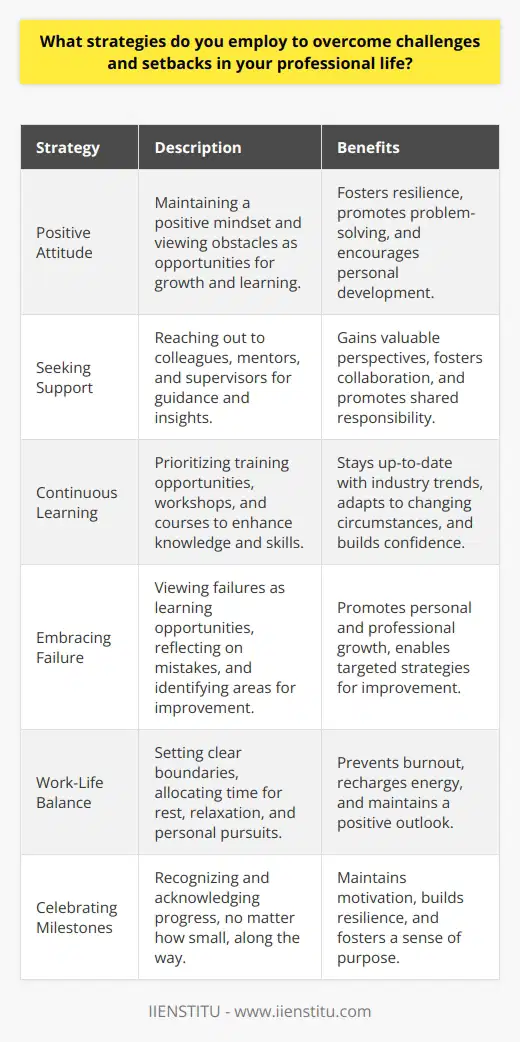
Can you describe a specific instance where you faced a setback at work and how you successfully addressed it?
Setbacks are an inevitable part of any professional journey, and how we address them can define our success. In my experience as a content writer for a marketing agency, I once encountered a significant setback when a client unexpectedly rejected an article I had written. The client's feedback indicated that the piece did not align with their brand voice and lacked the depth they expected.
Analyzing the Setback
Upon receiving the feedback, I took a step back to analyze the situation objectively. I carefully reviewed the client's brief and realized that I had misinterpreted some of their key requirements. This misinterpretation led to a disconnect between my writing and their expectations.
Developing a Plan of Action
To address the setback, I developed a plan of action. First, I scheduled a meeting with the client to gain a better understanding of their needs. During the meeting, I actively listened to their concerns and asked clarifying questions to ensure I had a clear grasp of their expectations.
Next, I created a detailed outline for the revised article, incorporating the client's feedback and requirements. I shared this outline with the client to ensure we were aligned before proceeding with the rewrite.
Implementing the Solution
With the client's approval of the outline, I began rewriting the article. I paid close attention to the brand voice and tone, ensuring that each paragraph resonated with the client's preferences. I also conducted additional research to provide more depth and substance to the piece.
Throughout the rewriting process, I maintained open communication with the client, providing regular updates and seeking their input. This collaborative approach helped to build trust and ensure that the final product met their expectations.
Learning from the Experience
After successfully delivering the revised article, I took time to reflect on the experience. I identified areas where I could improve my communication and interpretation skills to prevent similar setbacks in the future. I also recognized the importance of seeking clarification and maintaining open lines of communication with clients.
This setback taught me valuable lessons about adaptability, collaboration, and the significance of understanding client needs. By addressing the setback head-on, I not only salvaged the project but also strengthened my relationship with the client. The experience equipped me with the skills and mindset to handle future challenges more effectively.
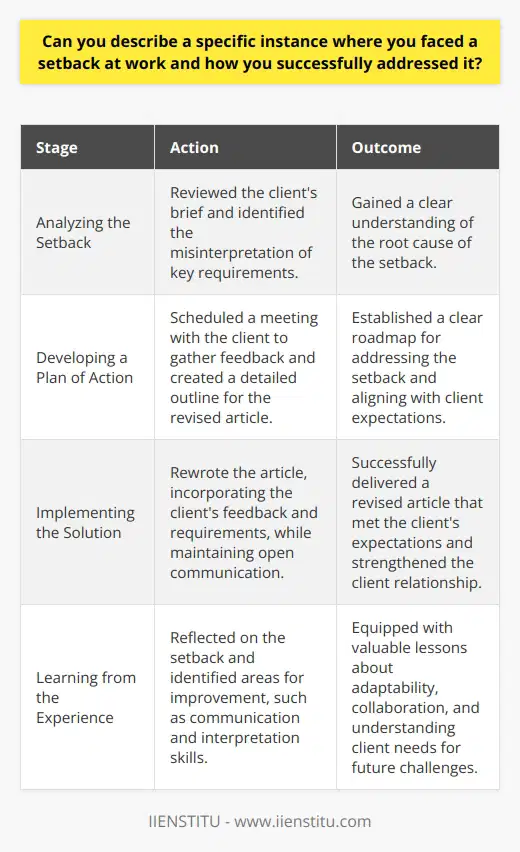
What are some common digital marketing interview questions and their answers in PDF format?
Digital marketing interviews often cover a wide range of topics, from basic concepts to more advanced strategies. Some common questions revolve around the candidate's understanding of various digital marketing channels, such as search engine optimization (SEO), pay-per-click (PPC) advertising, social media marketing, and email marketing. Interviewers may also ask about the candidate's experience with specific tools and platforms, like Google Analytics, Google Ads, or social media management tools.
Demonstrating Knowledge and Experience
Candidates should be prepared to discuss their previous digital marketing projects and the results they achieved. They may be asked to explain how they developed and implemented a successful campaign or how they addressed challenges along the way. Interviewers are often interested in seeing how candidates analyze data, make decisions, and adapt to changes in the digital landscape.
Problem-Solving and Analytical Skills
In addition to technical knowledge, digital marketing interviews often assess a candidate's problem-solving and analytical skills. Interviewers may present hypothetical scenarios and ask the candidate to develop a strategy or solution. This allows them to evaluate the candidate's ability to think critically, be creative, and make data-driven decisions.
Staying Up-to-Date with Industry Trends
Digital marketing is a constantly evolving field, so interviewers often ask candidates about their strategies for staying current. They may inquire about the blogs, podcasts, or industry events the candidate follows to stay informed about the latest trends and best practices. This demonstrates the candidate's passion for digital marketing and their commitment to continuous learning and growth.
Providing Answers in PDF Format
When preparing for a digital marketing interview, it can be helpful to compile your answers in a PDF document. This allows you to organize your thoughts, provide detailed examples, and showcase your knowledge in a clear and professional manner. Be sure to include relevant data, case studies, and visual aids to support your answers and make them more engaging.
Tailoring Your Answers to the Company
As you develop your interview answers, research the company and tailor your responses to their specific needs and goals. Demonstrate how your skills and experience align with their digital marketing objectives and how you can contribute to their success. By showing a genuine interest in the company and a deep understanding of their industry, you'll stand out as a strong candidate.
Practice and Preparation
Finally, remember that practice makes perfect. Review common digital marketing interview questions and practice delivering your answers out loud. This will help you feel more confident and articulate during the actual interview. Be prepared to discuss your achievements, challenges, and lessons learned, and don't forget to ask thoughtful questions of your own to show your engagement and enthusiasm for the role.
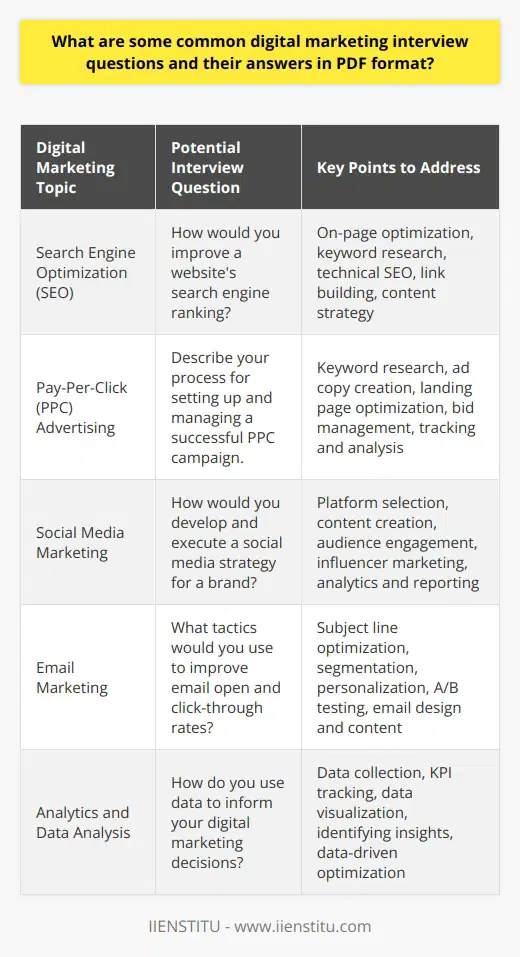
Where can I find a comprehensive PDF guide on digital marketing interview questions and answers?
Finding a comprehensive PDF guide on digital marketing interview questions and answers is possible through various online resources. You can start by searching for digital marketing interview guides on search engines like Google or Bing. Many websites offer free downloadable PDFs that cover a wide range of digital marketing topics and interview questions. These guides often include common questions asked by interviewers and provide detailed answers to help you prepare for your interview.
Explore Digital Marketing Blogs and Websites
Digital marketing blogs and websites are excellent sources for finding interview guides and preparation materials. Many of these sites have dedicated sections for job seekers, offering valuable insights into the interview process. Look for reputable digital marketing websites that regularly publish content related to career advice and interview preparation. These sites often feature articles, blog posts, and downloadable PDFs that cover digital marketing interview questions and answers.
Utilize Online Learning Platforms
Online learning platforms like Coursera, Udemy, and LinkedIn Learning offer courses on digital marketing. These courses often include interview preparation materials and guides as part of their curriculum. By enrolling in a digital marketing course, you can access comprehensive PDFs that cover interview questions and answers specific to the field. These platforms also provide the added benefit of learning from industry experts and gaining valuable knowledge to enhance your digital marketing skills.
Leverage Professional Networks and Forums
Engage with professional networks and forums related to digital marketing to find interview guides and resources. Platforms like LinkedIn have groups dedicated to digital marketing professionals where members share their experiences, insights, and resources. Join these groups and participate in discussions to connect with experienced professionals who can provide guidance and share interview preparation materials. You can also post questions or seek recommendations for comprehensive PDF guides on digital marketing interview questions and answers.
Consult Digital Marketing Recruitment Agencies
Digital marketing recruitment agencies often have valuable resources to help job seekers prepare for interviews. Reach out to recruitment agencies specializing in digital marketing positions and inquire about interview preparation materials. Many agencies have compiled comprehensive PDF guides that cover commonly asked interview questions and provide guidance on how to effectively answer them. These agencies have a deep understanding of the digital marketing industry and can offer tailored advice to help you succeed in your interviews.
Utilize Social Media Platforms
Social media platforms like Twitter, Facebook, and Instagram can be useful for finding digital marketing interview resources. Follow influential digital marketers, industry thought leaders, and marketing organizations on these platforms. They often share valuable content, including interview preparation tips and downloadable guides. Keep an eye out for posts that mention digital marketing interview questions and answers or provide links to comprehensive PDF guides.
Consider Purchasing Interview Preparation Books
In addition to free online resources, consider purchasing digital marketing interview preparation books from online bookstores or e-commerce platforms. Many authors and industry experts have written comprehensive guides that cover interview questions and answers specific to digital marketing. These books often provide in-depth explanations, real-life examples, and practical advice to help you ace your interviews. Read reviews and ratings to find highly recommended books that align with your needs.
Remember, while finding a comprehensive PDF guide is helpful, it's essential to combine it with other preparation strategies. Research the company you're interviewing with, practice your answers, and stay updated with the latest digital marketing trends and techniques. By leveraging multiple resources and dedicating time to preparation, you'll increase your chances of success in your digital marketing interviews.
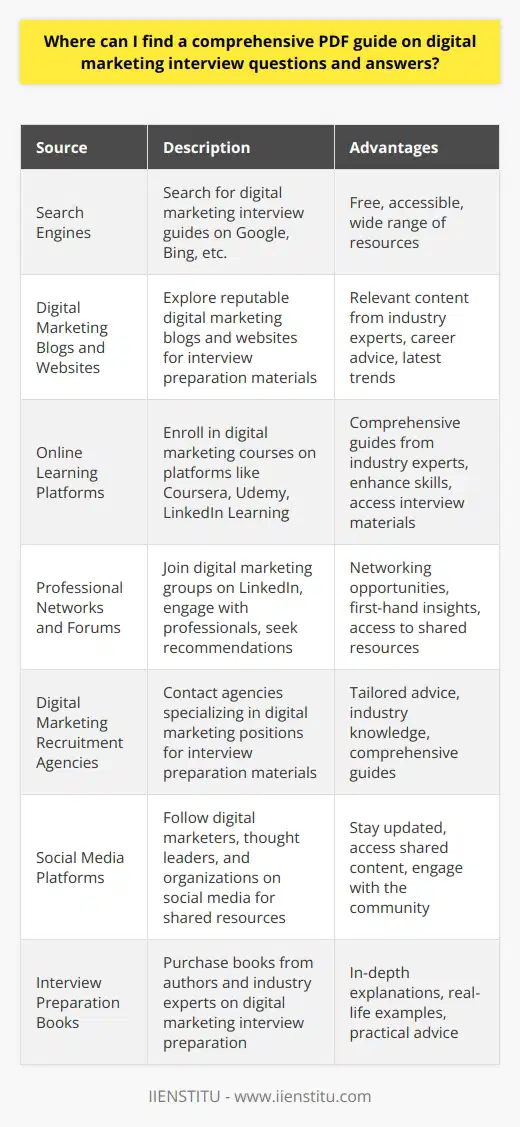
Can you recommend a reliable source for a PDF containing digital marketing interview questions and answers?
Finding a reliable source for a PDF containing digital marketing interview questions and answers can be challenging. It is essential to ensure the information is accurate, up-to-date, and relevant to the industry. One approach is to search for reputable websites, blogs, or online communities that specialize in digital marketing.
Reputable Websites and Blogs
Websites and blogs run by established digital marketing professionals or companies often provide valuable resources. These sites may offer free or paid PDFs, eBooks, or guides that cover interview questions and answers. Look for well-known names in the industry and check their content's quality before downloading.
Online Communities and Forums
Engaging with online communities and forums focused on digital marketing can be helpful. These platforms allow professionals to share their experiences, insights, and resources. You can ask for recommendations or search for threads discussing interview preparation materials. Be cautious and verify the credibility of shared resources.
Professional Organizations and Associations
Professional organizations and associations related to digital marketing may provide interview preparation resources. These groups aim to support and educate their members, often offering exclusive content. Check if they have a resource library or member-only section on their website. Some organizations may require membership to access certain materials.
Educational Institutions and Courses
Universities, colleges, and online learning platforms that offer digital marketing courses may have interview preparation resources. These institutions often have faculty with industry experience who can provide valuable insights. Check if they have a career services department or alumni network that shares interview tips and sample questions.
Evaluating the Reliability of Sources
When assessing the reliability of a source for digital marketing interview questions and answers, consider the following factors:
Author's Credibility
Research the author or organization behind the PDF. Look for their qualifications, experience, and reputation within the industry. Credible sources often have a proven track record and are recognized by their peers.
Content Quality and Relevance
Evaluate the quality and relevance of the content within the PDF. The questions and answers should be well-structured, comprehensive, and aligned with current digital marketing practices. Avoid sources that provide outdated or generic information.
User Reviews and Feedback
Look for user reviews and feedback on the source or PDF. Positive testimonials from other digital marketing professionals can indicate the resource's reliability and effectiveness. Be cautious of sources with limited or negative reviews.
In conclusion, finding a reliable source for digital marketing interview questions and answers requires thorough research and evaluation. Reputable websites, online communities, professional organizations, and educational institutions are good starting points. Assess the credibility of the author, content quality, and user feedback to ensure you obtain accurate and valuable information.
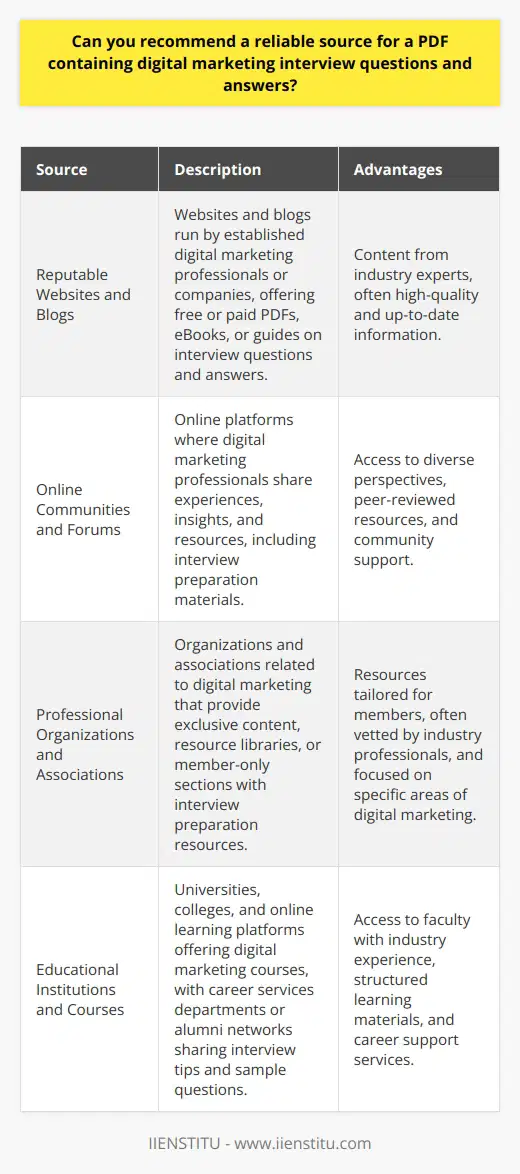
What inspired you to pursue a career in digital marketing?
Digital marketing has become an increasingly fascinating field, offering a dynamic and ever-evolving landscape for professionals to explore. The inspiration to pursue a career in this domain stems from several key factors that have captivated my interest and ignited my passion for this innovative industry.
The Power of Technology
One of the primary drivers behind my decision to embark on a digital marketing career is the transformative power of technology. The rapid advancements in digital platforms and tools have revolutionized the way businesses connect with their target audiences. The ability to leverage cutting-edge technologies to create compelling and personalized marketing strategies is truly exhilarating.
Data-Driven Insights
Digital marketing provides access to a wealth of data and analytics, enabling marketers to make informed decisions. The opportunity to dive deep into consumer behavior, preferences, and trends is incredibly appealing. By harnessing the power of data, digital marketers can optimize campaigns, enhance user experiences, and drive meaningful results.
Creativity and Innovation
The digital marketing landscape is a playground for creativity and innovation. The constant emergence of new platforms, technologies, and trends presents endless opportunities to think outside the box and develop groundbreaking marketing strategies. The chance to combine artistic vision with data-driven insights is an exciting prospect that fuels my desire to pursue this career path.
Storytelling in the Digital Age
Digital marketing allows brands to tell their stories in captivating and interactive ways. The ability to craft compelling narratives that resonate with audiences across various digital channels is a skill I am eager to master. Through engaging content, visuals, and multimedia experiences, digital marketers have the power to build strong emotional connections with consumers.
Measurable Impact
One of the most gratifying aspects of digital marketing is the ability to measure the impact of campaigns in real-time. Unlike traditional marketing methods, digital channels provide tangible metrics and analytics that allow marketers to assess the effectiveness of their strategies. The satisfaction of seeing measurable results and being able to optimize campaigns based on data-driven insights is highly motivating.
Continuous Learning and Growth
The digital marketing industry is constantly evolving, presenting endless opportunities for learning and professional growth. The need to stay updated with the latest trends, technologies, and best practices keeps me engaged and motivated. The prospect of continuously expanding my skill set and adapting to the ever-changing digital landscape is both challenging and exciting.
Conclusion
Pursuing a career in digital marketing is a thrilling journey driven by a passion for technology, creativity, and measurable impact. The ability to leverage data, tell compelling stories, and connect with audiences in innovative ways is what truly inspires me. As I embark on this path, I am eager to contribute to the dynamic world of digital marketing and make a meaningful difference in the way brands engage with their customers.
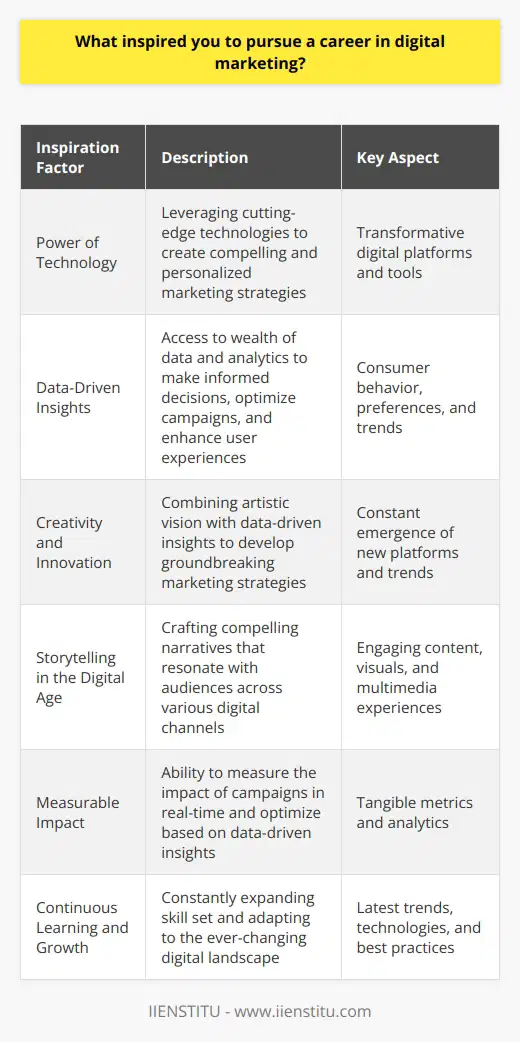
How do you stay up-to-date with the latest trends and best practices in digital marketing?
Staying up-to-date with the latest trends and best practices in digital marketing is crucial for success. One effective method is to regularly read industry blogs and publications. These resources provide valuable insights into emerging trends, case studies, and expert opinions. Subscribing to newsletters and following thought leaders on social media can also keep you informed. Attending conferences and webinars is another excellent way to learn from experts and network with peers. These events offer opportunities to discuss challenges, share experiences, and gain new perspectives. Participating in online forums and communities can also help you stay current. These platforms allow you to engage with other professionals, ask questions, and share knowledge. Continuously experimenting with new strategies and tools is essential for staying ahead of the curve. By testing different approaches, you can identify what works best for your audience and adapt accordingly. Regularly analyzing your own data and metrics can provide valuable insights into your performance and areas for improvement.
Read Industry Blogs and Publications
Reading industry blogs and publications is a simple yet effective way to stay informed about digital marketing trends. Many reputable sources publish articles, case studies, and expert opinions on a regular basis. These resources can provide valuable insights into emerging technologies, successful strategies, and best practices. By dedicating time to reading these materials, you can expand your knowledge and stay ahead of the curve. Some popular industry blogs include Search Engine Journal, Marketing Land, and Social Media Examiner. These sites cover a wide range of topics, from SEO and PPC to content marketing and social media.
Subscribe to Newsletters and Follow Thought Leaders
Subscribing to newsletters and following thought leaders on social media can also keep you up-to-date. Many industry experts and influencers share their insights and opinions through these channels. By following them, you can gain access to the latest news, trends, and best practices. Newsletters often curate the most relevant and valuable content, making it easier for you to stay informed without spending hours searching for information. Social media platforms like Twitter and LinkedIn are also excellent sources of real-time updates and discussions. Following hashtags and joining relevant groups can help you discover new ideas and connect with other professionals.
Attend Conferences and Webinars
Attending conferences and webinars is another excellent way to stay up-to-date with digital marketing trends. These events bring together experts and professionals from various industries to share their knowledge and experiences. By attending these events, you can learn about the latest strategies, tools, and best practices. You can also network with other attendees, exchange ideas, and build relationships. Many conferences and webinars offer virtual attendance options, making it easier to participate from anywhere in the world. Some popular digital marketing conferences include Content Marketing World, MozCon, and Social Media Marketing World.
Participate in Online Forums and Communities
Participating in online forums and communities can also help you stay current with digital marketing trends. These platforms allow you to engage with other professionals, ask questions, and share knowledge. By joining relevant groups and discussions, you can learn from others' experiences and gain new perspectives. You can also contribute your own insights and help others in the community. Some popular online communities for digital marketers include Inbound.org, GrowthHackers, and Reddit's various marketing subreddits. These communities are excellent resources for staying up-to-date, troubleshooting challenges, and connecting with like-minded professionals.
Experiment with New Strategies and Tools
Continuously experimenting with new strategies and tools is essential for staying ahead in digital marketing. By testing different approaches, you can identify what works best for your audience and adapt accordingly. This process of experimentation and optimization allows you to stay current with the latest trends and best practices. It also helps you discover new opportunities and stay ahead of the competition. When experimenting with new strategies and tools, it's essential to have clear goals and metrics in place. This allows you to measure your success and make data-driven decisions. Some areas to experiment with include new ad formats, emerging social media platforms, and AI-powered tools.
Analyze Your Own Data and Metrics

Can you describe a successful digital marketing campaign you have worked on and the strategies you employed?
One successful digital marketing campaign I worked on involved promoting a new line of eco-friendly products. The campaign aimed to raise awareness about the brand and drive sales. To achieve these goals, we implemented a multi-faceted strategy that included various digital marketing channels and tactics.
Identifying the Target Audience
We began by conducting thorough market research to identify our target audience. This involved analyzing consumer behavior, preferences, and demographics. By understanding our target audience, we could tailor our messaging and strategies to effectively reach and engage them.
Developing a Strong Brand Identity
To establish a strong brand identity, we created a cohesive visual language and messaging across all digital platforms. This included designing a logo, color scheme, and typography that reflected the brand's eco-friendly values. We also developed a brand voice that resonated with our target audience.
Creating Engaging Content
Content played a crucial role in our digital marketing campaign. We created a variety of engaging and informative content pieces, including blog posts, infographics, and videos. These content pieces aimed to educate consumers about the benefits of eco-friendly products and showcase how our brand's offerings could contribute to a more sustainable lifestyle.
Leveraging Social Media
Social media was a key component of our digital marketing strategy. We utilized platforms like Facebook, Instagram, and Twitter to reach our target audience. We regularly posted engaging content, ran targeted ads, and encouraged user-generated content through hashtag campaigns. This helped us build a strong community around the brand and foster customer engagement.
Influencer Partnerships
To further expand our reach and credibility, we partnered with relevant influencers in the eco-friendly and sustainability space. These influencers created sponsored content, product reviews, and social media posts that showcased our brand's products. Collaborating with influencers helped us tap into their established follower base and gain trust among our target audience.
Email Marketing
Email marketing allowed us to directly communicate with our subscribers and keep them engaged with the brand. We developed a series of email campaigns that provided valuable content, exclusive offers, and updates about our eco-friendly products. By segmenting our email list based on subscriber preferences and behavior, we could deliver personalized and relevant content to each individual.
Measuring and Analyzing Results
Throughout the campaign, we continuously monitored and analyzed key performance indicators (KPIs) to measure its effectiveness. We tracked metrics such as website traffic, conversion rates, social media engagement, and email open rates. By regularly reviewing and adjusting our strategies based on data-driven insights, we could optimize our efforts and maximize the campaign's impact.
Campaign Success
The digital marketing campaign was highly successful in achieving its objectives. We observed a significant increase in brand awareness, website traffic, and sales of our eco-friendly products. The campaign also helped establish our brand as a leader in the sustainable lifestyle space and fostered a loyal customer base.
In conclusion, this successful digital marketing campaign demonstrated the power of a well-planned and executed strategy. By identifying our target audience, creating engaging content, leveraging social media, partnering with influencers, and utilizing email marketing, we were able to effectively promote our brand and drive meaningful results.
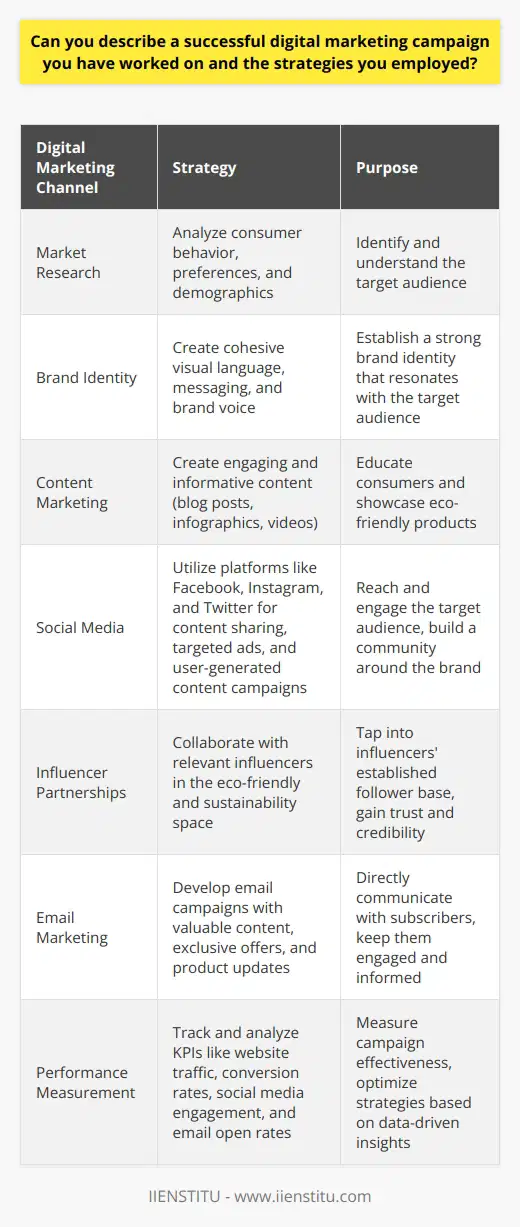
How do you typically respond to failure and what do you learn from it?
Failure is an inevitable part of life, and how we respond to it can greatly impact our personal growth and future success. When faced with failure, it is essential to approach the situation with a positive and constructive mindset, viewing it as an opportunity to learn and improve rather than a setback or defeat.
Acknowledging and Accepting Failure
The first step in responding to failure is to acknowledge and accept it. Denying or avoiding the reality of failure will only hinder your ability to move forward and learn from the experience. Accepting failure involves taking responsibility for your actions and decisions that may have contributed to the outcome.
Analyzing the Causes of Failure
Once you have accepted the failure, it is crucial to analyze the causes behind it. Take the time to reflect on the factors that led to the unsuccessful outcome, whether they were within your control or external circumstances. This analysis will help you identify areas where you can improve and make necessary adjustments for future endeavors.
Identifying Personal Shortcomings
During the analysis process, be honest with yourself about any personal shortcomings that may have contributed to the failure. This could include lack of preparation, poor time management, or inadequate skills in a particular area. Recognizing these weaknesses is the first step in addressing them and working towards self-improvement.
Evaluating External Factors
In addition to personal factors, it is important to consider external factors that may have influenced the outcome. This could include market conditions, competition, or unforeseen obstacles. While these factors may be beyond your control, understanding their impact can help you adapt and develop contingency plans for future situations.
Learning from Failure
The most significant aspect of responding to failure is the ability to learn from it. Failure provides valuable lessons and insights that can be applied to future endeavors, increasing the chances of success. By reflecting on the experience and identifying areas for improvement, you can turn failure into a stepping stone towards personal and professional growth.
Developing Resilience
Experiencing failure can also help develop resilience, which is the ability to bounce back from setbacks and persevere in the face of adversity. Each time you encounter failure and successfully navigate through it, you strengthen your resilience and become better equipped to handle future challenges.
Fostering a Growth Mindset
Embracing failure as a learning opportunity fosters a growth mindset, which is the belief that abilities and intelligence can be developed through dedication and hard work. By viewing failure as a chance to grow and improve, you can maintain motivation and persist in the pursuit of your goals, even in the face of obstacles.
Moving Forward
After analyzing the failure and extracting valuable lessons, it is essential to move forward with a renewed sense of purpose and determination. Use the insights gained from the experience to create a plan of action for future endeavors, incorporating the knowledge and skills acquired through the process of overcoming failure.
In conclusion, responding to failure in a constructive and positive manner is crucial for personal and professional growth. By acknowledging and accepting failure, analyzing its causes, and learning from the experience, individuals can develop resilience, foster a growth mindset, and increase their chances of future success. Embracing failure as an opportunity to learn and improve is a key characteristic of successful individuals who continue to push boundaries and achieve their goals.
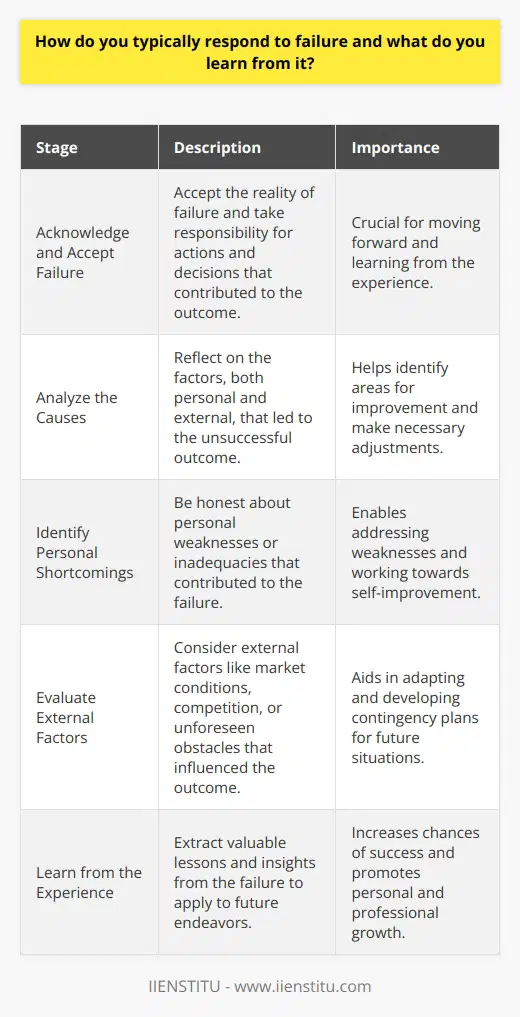
How do you stay motivated and handle success without becoming complacent?
Staying motivated and handling success without becoming complacent requires a proactive approach to personal and professional development. One effective strategy is setting clear, achievable goals that align with your values and aspirations. Break these goals down into smaller, manageable tasks and celebrate each milestone along the way. This helps maintain momentum and prevents stagnation.
Continuous Learning and Growth
Engage in continuous learning and seek out new challenges to expand your knowledge and skills. Embrace a growth mindset, viewing obstacles as opportunities for learning and improvement. Regularly assess your progress and adjust your strategies as needed to stay on track.
Surround Yourself with Positive Influences
Surround yourself with supportive and motivated individuals who share your values and inspire you to be your best. Engage in meaningful conversations and collaborate on projects that challenge and stimulate your mind. Seek out mentors and role models who can provide guidance and perspective.
Practice Gratitude and Self-Reflection
Cultivate a practice of gratitude, acknowledging the positive aspects of your life and accomplishments. Take time for regular self-reflection to assess your progress, identify areas for improvement, and reconnect with your purpose. This helps maintain a balanced perspective and prevents complacency from setting in.
Embrace a Healthy Work-Life Balance
Prioritize self-care and maintain a healthy work-life balance to prevent burnout and maintain motivation. Engage in activities that bring you joy and fulfillment outside of work, such as hobbies, exercise, or spending time with loved ones. Taking regular breaks and disconnecting from work helps recharge your batteries and maintain a fresh perspective.
Contribute to Something Greater Than Yourself
Find ways to contribute to something greater than yourself, whether through volunteering, mentoring, or supporting causes you believe in. Giving back to your community or helping others can provide a sense of purpose and fulfillment, keeping you motivated and grounded in the face of success.
Embrace Failure as a Learning Opportunity
View failure as a natural part of the learning and growth process, rather than a setback. Embrace challenges and take calculated risks, learning from your mistakes and using them as stepping stones to future success. This mindset helps maintain resilience and prevents complacency from setting in.
Celebrate Your Successes and Accomplishments
Take time to celebrate your successes and accomplishments, no matter how small they may seem. Acknowledge your hard work and dedication, and share your achievements with others who have supported you along the way. This helps maintain a positive outlook and prevents success from becoming mundane or expected.
By implementing these strategies and maintaining a proactive approach to personal and professional development, you can stay motivated and handle success without falling into the trap of complacency. Remember that success is a journey, not a destination, and there is always room for growth and improvement.

How do you handle a failed digital marketing campaign and what steps do you take to learn from the experience?
Handling a failed digital marketing campaign requires a systematic approach to identify the root causes and learn from the experience. The first step is to conduct a thorough post-mortem analysis of the campaign. This involves reviewing all aspects of the campaign, including the strategy, targeting, messaging, and execution. By analyzing the data and metrics, marketers can pinpoint the areas where the campaign fell short and identify opportunities for improvement.
Identify the Root Causes
During the post-mortem analysis, it's crucial to ask questions and gather insights from all stakeholders involved in the campaign. This includes the marketing team, sales team, and any external partners or agencies. By collaborating and sharing information, marketers can gain a comprehensive understanding of what went wrong and why.
Common reasons for a failed digital marketing campaign include misaligned targeting, ineffective messaging, poor timing, and technical issues. By identifying the root causes, marketers can develop a plan to address these issues and prevent them from occurring in future campaigns.
Develop an Action Plan
Once the root causes have been identified, the next step is to develop an action plan to address them. This may involve adjusting the targeting strategy, refining the messaging, or improving the technical infrastructure. It's important to prioritize the actions based on their potential impact and feasibility.
The action plan should also include specific goals and metrics to measure the success of future campaigns. By setting clear objectives and tracking progress, marketers can ensure that they are making meaningful improvements and avoiding the same mistakes.
Test and Iterate
Digital marketing is an iterative process, and it's essential to continuously test and refine campaigns based on data and insights. By conducting small-scale tests and experiments, marketers can validate their assumptions and optimize their strategies before launching full-scale campaigns.
This approach allows marketers to minimize risk and maximize the chances of success. It also enables them to learn from each iteration and apply those lessons to future campaigns.
Foster a Culture of Learning
Finally, it's important to foster a culture of learning within the marketing team and the wider organization. This means encouraging experimentation, embracing failure as an opportunity to learn, and sharing knowledge and insights across teams.
By creating a safe and supportive environment for learning, marketers can drive innovation and continuous improvement in their digital marketing efforts. This mindset shift can help organizations stay ahead of the curve and adapt to the ever-changing digital landscape.
Conclusion
Handling a failed digital marketing campaign requires a proactive and data-driven approach. By conducting a thorough post-mortem analysis, identifying the root causes, developing an action plan, testing and iterating, and fostering a culture of learning, marketers can turn failure into an opportunity for growth and improvement. By embracing this mindset and applying these strategies, organizations can optimize their digital marketing efforts and achieve better results over time.
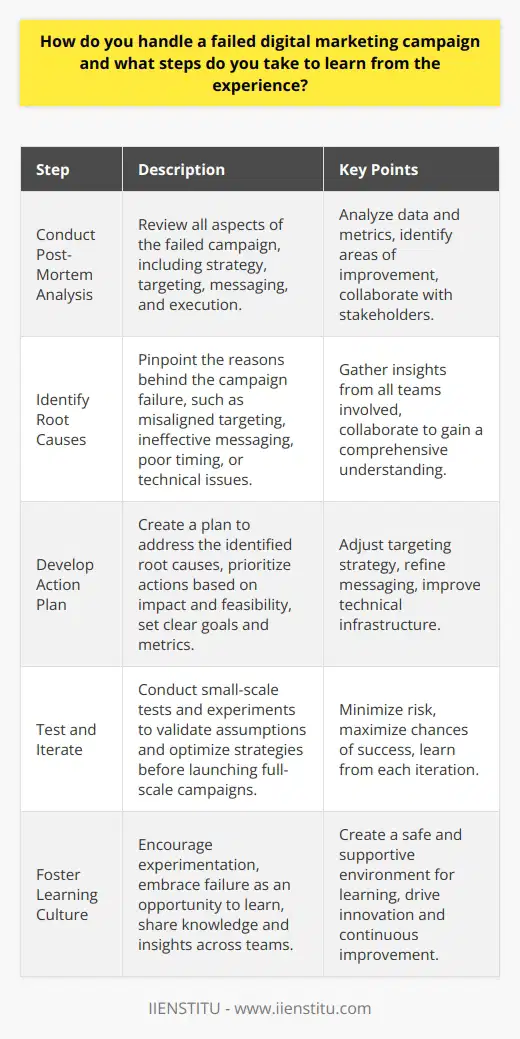
In your experience, what are the most common reasons for digital marketing failures and how can they be avoided?
Digital marketing failures often stem from a lack of clear objectives, inadequate research, and poor execution. To avoid these pitfalls, marketers must first establish well-defined goals that align with their overall business strategy. This involves conducting thorough market research to identify target audiences, competitors, and industry trends. By gathering and analyzing this data, marketers can develop a comprehensive understanding of their market and create targeted campaigns that resonate with their intended audience.
Importance of a Cohesive Strategy
Another common reason for digital marketing failures is the absence of a cohesive strategy across multiple channels. In today's digital landscape, consumers interact with brands through various touchpoints, such as social media, email, and websites. Marketers must ensure that their messaging and branding remain consistent across all platforms to create a seamless user experience. This involves developing a unified content strategy that considers the unique characteristics and best practices of each channel while maintaining a consistent brand voice and visual identity.
Adapting to Changing Technologies and Consumer Behaviors
Failing to adapt to changing technologies and consumer behaviors can also contribute to digital marketing failures. As new platforms and devices emerge, marketers must stay up-to-date with the latest trends and best practices to effectively reach and engage their target audience. This requires a willingness to experiment with new tactics and technologies, as well as a commitment to continuous learning and improvement. By embracing a data-driven approach and leveraging tools like analytics and A/B testing, marketers can optimize their campaigns in real-time and make informed decisions based on actual performance data.
Allocating Sufficient Resources
Insufficient resource allocation is another factor that can lead to digital marketing failures. Effective digital marketing requires a significant investment of time, money, and talent. Marketers must ensure that they have the necessary resources to plan, execute, and measure their campaigns effectively. This includes building a skilled team of professionals with expertise in various digital marketing disciplines, such as content creation, social media management, and data analysis. Additionally, marketers should allocate adequate budgets to support their initiatives and invest in the right tools and technologies to streamline their processes and maximize their results.
Measuring and Optimizing Performance
Finally, failing to measure and optimize campaign performance can also contribute to digital marketing failures. Without clear metrics and regular analysis, marketers cannot determine the effectiveness of their efforts or identify areas for improvement. To avoid this, marketers must establish key performance indicators (KPIs) that align with their objectives and regularly track and report on their progress. By using data to inform their decisions and continuously refining their strategies based on performance insights, marketers can improve the efficiency and impact of their digital marketing efforts over time.

Can you describe a specific example of a digital marketing fail you encountered and how you successfully addressed the issue?
One specific example of a digital marketing fail I encountered involved a poorly targeted social media ad campaign. The company had invested a significant amount of resources into creating visually appealing ads, but they failed to properly define their target audience. As a result, the ads were shown to individuals who had little to no interest in the product being promoted, leading to low engagement rates and a poor return on investment.
Identifying the Problem
To address this issue, the first step was to identify the root cause of the problem. After analyzing the data and reviewing the ad targeting settings, it became clear that the company had not taken the time to thoroughly research and understand their ideal customer persona. They had made assumptions about their target audience without gathering sufficient data to support their decisions.
Conducting Market Research
To rectify the situation, I recommended conducting in-depth market research to gain a better understanding of the company's target audience. This involved surveying current customers, analyzing competitor strategies, and gathering demographic and psychographic data. By doing so, we were able to create a more accurate and detailed customer persona that aligned with the company's product offerings.
Refining Ad Targeting
Armed with this new information, we proceeded to refine the ad targeting settings. We segmented the audience based on factors such as age, gender, interests, and online behaviors. This allowed us to deliver the ads to individuals who were more likely to be interested in the product, increasing the chances of engagement and conversions.
Optimizing Ad Content
In addition to improving the targeting, we also optimized the ad content itself. We conducted A/B tests to determine which ad copy, visuals, and calls-to-action resonated best with the target audience. By continuously monitoring and analyzing the performance data, we were able to make data-driven decisions and iterate on the ad content to improve its effectiveness.
Monitoring and Adjusting
Throughout the campaign, we closely monitored the performance metrics, including click-through rates, conversion rates, and cost per acquisition. By regularly reviewing this data, we were able to identify any areas that needed further improvement and make timely adjustments to the campaign strategy.
Achieving Successful Results
As a result of these efforts, we were able to turn the failing digital marketing campaign into a success. The improved targeting and optimized ad content led to a significant increase in engagement rates and conversions. The company saw a higher return on investment and was able to reach its desired audience more effectively.
Key Takeaways
This experience taught me the importance of thorough market research, data-driven decision making, and continuous optimization in digital marketing. It highlighted the need to truly understand the target audience and tailor the marketing strategy accordingly. By addressing the issue systematically and leveraging data insights, we were able to overcome the initial failure and achieve successful results for the company.
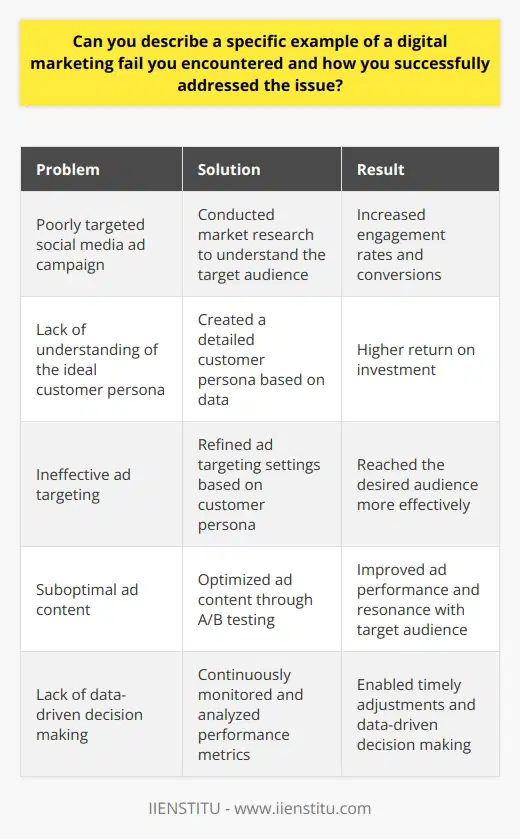
How do you handle a digital marketing campaign that fails to meet its objectives?
Handling a digital marketing campaign that fails to meet its objectives requires a systematic approach. The first step is to conduct a thorough analysis of the campaign's performance data. This includes examining metrics such as click-through rates, conversion rates, and engagement levels. By identifying the areas where the campaign underperformed, marketers can pinpoint the specific issues that need to be addressed.
Identifying the Root Causes
Once the performance data has been analyzed, the next step is to identify the root causes of the campaign's failure. This may involve looking at factors such as the targeting strategy, the ad creative, or the landing page design. It's important to consider both internal and external factors that may have contributed to the campaign's underperformance. For example, changes in the competitive landscape or shifts in consumer behavior could have impacted the campaign's effectiveness.
Conducting A/B Testing
To determine the specific elements that need improvement, marketers can conduct A/B testing. This involves creating variations of the campaign's components and testing them against each other. By comparing the performance of different versions, marketers can identify the elements that resonate with the target audience and make data-driven decisions to optimize the campaign.
Adjusting the Strategy
Based on the insights gained from the analysis and A/B testing, marketers can adjust the campaign strategy. This may involve refining the targeting criteria, revising the ad creative, or optimizing the landing pages. It's important to make incremental changes and continuously monitor the campaign's performance to ensure that the adjustments are having the desired effect.
Leveraging Retargeting
Retargeting can be a powerful tool for re-engaging users who interacted with the campaign but did not convert. By serving targeted ads to these individuals, marketers can remind them of their interest and encourage them to take action. Retargeting allows marketers to capitalize on the initial investment made in the campaign and improve the overall return on investment.
Learning from Failure
While it's disappointing when a digital marketing campaign fails to meet its objectives, it's important to view it as a learning opportunity. By analyzing the campaign's shortcomings and making data-driven adjustments, marketers can improve their understanding of what works and what doesn't. This knowledge can be applied to future campaigns, increasing the likelihood of success.
Documenting the Process
To ensure that the lessons learned from a failed campaign are not forgotten, it's crucial to document the process. This includes recording the initial objectives, the performance data, the insights gained, and the adjustments made. By creating a comprehensive record of the campaign, marketers can refer back to it in the future and apply the knowledge gained to similar campaigns.
Maintaining a Long-Term Perspective
It's important to remember that digital marketing is an ongoing process, not a one-time event. While a single campaign may not meet its objectives, it's essential to maintain a long-term perspective. By continuously learning, adapting, and refining their approach, marketers can improve their overall digital marketing strategy and achieve sustained success over time.

What strategies would you employ to recover from a failed digital marketing initiative?
Recovering from a failed digital marketing initiative requires a systematic approach that involves analyzing the situation, identifying areas for improvement, and implementing corrective measures. The first step is to conduct a thorough post-mortem analysis of the failed campaign. This involves reviewing the campaign's objectives, strategies, and tactics to determine what went wrong and why.
Identify Areas for Improvement
Once the root causes of the failure have been identified, the next step is to identify areas for improvement. This may involve revisiting the target audience, adjusting the messaging, or revising the marketing channels used. It is important to be honest and objective in this process, as it will help to prevent similar mistakes from occurring in the future.
Develop a New Strategy
Based on the insights gained from the post-mortem analysis and the areas for improvement, the next step is to develop a new strategy. This should involve setting new objectives, defining a new target audience, and selecting the most effective marketing channels. The new strategy should be data-driven and based on a clear understanding of the audience's needs and preferences.
Implement and Monitor
Once the new strategy has been developed, it is important to implement it carefully and monitor its performance closely. This may involve conducting regular audits of the campaign's performance, analyzing data, and making adjustments as needed. It is also important to communicate regularly with stakeholders and keep them informed of the campaign's progress.
Learn from Mistakes
Finally, it is important to learn from the mistakes made in the failed campaign and use those lessons to improve future initiatives. This may involve documenting the lessons learned, sharing them with the team, and incorporating them into future planning processes. By taking a proactive approach to learning from failures, organizations can improve their digital marketing efforts and achieve better results over time.
In conclusion, recovering from a failed digital marketing initiative requires a systematic approach that involves analyzing the situation, identifying areas for improvement, developing a new strategy, implementing and monitoring the new campaign, and learning from mistakes. By following these steps and maintaining a focus on continuous improvement, organizations can bounce back from failures and achieve success in their digital marketing efforts.

In the event of a digital marketing failure, how would you analyze the situation and develop a plan to prevent future missteps?
Analyzing a digital marketing failure requires a systematic approach to identify the root causes and develop preventive measures. The first step involves gathering data from various sources, such as website analytics, social media metrics, and customer feedback. This data will help pinpoint the areas where the campaign fell short of expectations.
Once the data is collected, it's crucial to conduct a thorough analysis to uncover patterns and trends. Look for anomalies in traffic, engagement rates, conversion rates, and other key performance indicators (KPIs). Identify any technical issues, such as slow page load times or broken links, that may have hindered the campaign's success.
Evaluate the Target Audience
Assess whether the campaign effectively reached the intended target audience. Review the demographic data, interests, and behaviors of the individuals who interacted with the campaign. Determine if there was a mismatch between the campaign's messaging and the audience's preferences.
Analyze the Content and Messaging
Evaluate the quality and relevance of the content used in the campaign. Assess whether the messaging was clear, compelling, and aligned with the brand's values. Consider if the content format (e.g., text, images, videos) was appropriate for the target audience and the platform used.
Review the Campaign Strategy
Examine the overall strategy behind the digital marketing campaign. Assess whether the goals were clearly defined and measurable. Review the tactics used, such as paid advertising, social media promotion, or email marketing, and evaluate their effectiveness in achieving the desired outcomes.
Identify External Factors
Consider any external factors that may have influenced the campaign's performance. This could include changes in market trends, competitor activities, or unforeseen events that impacted consumer behavior. Assess how these factors may have contributed to the campaign's failure.
Develop a Plan for Future Success
Based on the analysis, create a comprehensive plan to prevent future digital marketing missteps. This plan should include the following:
Set Clear Goals and KPIs
Define specific, measurable, achievable, relevant, and time-bound (SMART) goals for future campaigns. Establish KPIs that align with these goals and track progress regularly.
Conduct Thorough Market Research
Invest time and resources in understanding your target audience. Conduct surveys, focus groups, and analyze customer data to gain insights into their preferences, behaviors, and pain points. Use this information to create targeted and relevant campaigns.
Test and Optimize
Implement a testing strategy to optimize various elements of your digital marketing campaigns. Conduct A/B tests on ad copy, landing pages, and email subject lines to identify the best-performing variants. Continuously monitor and adjust your campaigns based on data-driven insights.
Foster Collaboration and Communication
Encourage open communication and collaboration among team members involved in digital marketing efforts. Regularly share insights, best practices, and lessons learned to foster a culture of continuous improvement.
By following this approach, you can systematically analyze a digital marketing failure, identify the root causes, and develop a robust plan to prevent future missteps. Remember, failure is an opportunity to learn and grow, and by embracing a data-driven and iterative approach, you can set your digital marketing efforts up for long-term success.
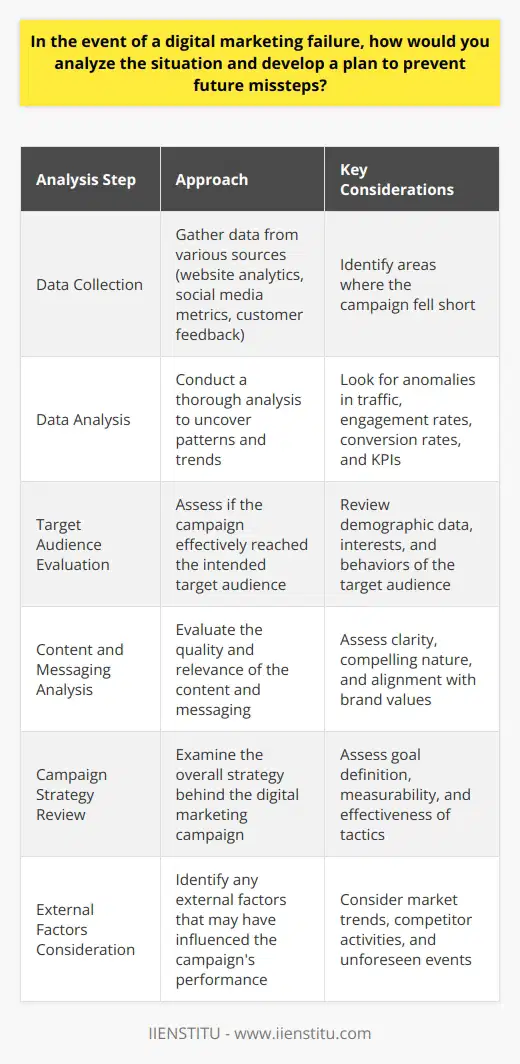
How do you handle failure in your professional life?
Handling failure in one's professional life is a crucial skill that can determine long-term success and growth. It requires a combination of resilience, self-reflection, and adaptability to overcome setbacks and learn from them. When faced with failure, it is essential to maintain a positive attitude and view the experience as an opportunity for improvement rather than a definitive defeat.
Acknowledge and Accept Failure
The first step in dealing with failure is to acknowledge and accept it. Recognize that failure is a natural part of the learning process and that everyone experiences it at some point in their career. By accepting failure, you can focus on moving forward and finding solutions rather than dwelling on the negative aspects of the situation.
Analyze and Learn from Mistakes
Once you have accepted the failure, take the time to analyze what went wrong. Identify the factors that contributed to the failure and consider what you could have done differently. This self-reflection process allows you to gain valuable insights and learn from your mistakes, reducing the likelihood of repeating them in the future.
Seek Feedback and Support
Don't hesitate to seek feedback and support from colleagues, mentors, or supervisors. They can provide valuable perspectives and advice on how to overcome the failure and improve your performance. Surround yourself with supportive individuals who encourage you to learn and grow from your experiences.
Develop a Plan of Action
After analyzing the failure and gathering feedback, develop a plan of action to address the issues and prevent similar failures in the future. Break down the plan into manageable steps and set realistic goals for improvement. This proactive approach demonstrates your commitment to personal and professional growth.
Embrace a Growth Mindset
Adopt a growth mindset, which views failure as a temporary setback and an opportunity for learning and development. Embrace challenges and view them as chances to expand your skills and knowledge. Celebrate small successes along the way and maintain a positive outlook on your ability to overcome obstacles.
Maintain Resilience and Perseverance
Resilience and perseverance are key qualities in handling failure. Recognize that setbacks are temporary and that success often requires persistence and determination. Stay focused on your long-term goals and continue to work towards them, even in the face of adversity. Celebrate your successes, no matter how small, to maintain motivation and momentum.
Learn from the Success of Others
Look to successful individuals in your field and learn from their experiences. Study how they have handled failure and overcome obstacles in their careers. Seek out mentors or role models who can provide guidance and inspiration as you navigate your own professional journey.
Conclusion
Handling failure in your professional life is an ongoing process that requires a combination of self-awareness, resilience, and a willingness to learn and grow. By acknowledging and accepting failure, analyzing mistakes, seeking support, developing a plan of action, embracing a growth mindset, and maintaining perseverance, you can transform setbacks into valuable learning experiences that contribute to your long-term success.

How do you typically respond when faced with failure?
When confronted with failure, individuals often exhibit a range of responses that can significantly impact their future success. Some people may experience feelings of frustration, disappointment, or even despair when faced with setbacks. These emotions can lead to a temporary loss of motivation and a reluctance to try again. However, it is crucial to recognize that failure is an inherent part of the learning and growth process.
Embracing Failure as a Learning Opportunity
One effective way to respond to failure is by viewing it as a valuable learning opportunity. By analyzing the factors that contributed to the unfavorable outcome, individuals can gain insights into areas that require improvement. This reflective process allows for the identification of weaknesses, knowledge gaps, or flawed strategies. Armed with this information, people can develop targeted plans to address these shortcomings and increase their chances of success in future endeavors.
Cultivating Resilience and Perseverance
Resilience and perseverance are essential qualities when responding to failure. Resilient individuals can bounce back from setbacks and maintain a positive outlook despite the challenges they encounter. They understand that failure is not a permanent state but rather a temporary obstacle to overcome. By cultivating a growth mindset, which embraces challenges and views failure as an opportunity for development, individuals can foster the mental toughness necessary to persevere through difficult times.
Seeking Support and Guidance
Another constructive response to failure is seeking support and guidance from others. Engaging with mentors, peers, or experts in the relevant field can provide valuable perspectives and advice. These individuals can offer encouragement, share their own experiences with failure, and suggest strategies for improvement. Building a strong support network can help individuals maintain motivation, gain new insights, and feel less alone in their struggles.
Reframing Failure as a Stepping Stone
Reframing failure as a stepping stone towards future success is a powerful cognitive strategy. By viewing setbacks as necessary steps on the path to achievement, individuals can maintain a sense of perspective and avoid becoming discouraged. This mindset shift involves recognizing that each failure brings them closer to their goals by eliminating ineffective approaches and refining their skills. Embracing failure as a natural part of the journey can help individuals stay focused on their long-term objectives and remain motivated to try again.
Celebrating Small Wins and Incremental Progress
While it is important to learn from failure, it is equally crucial to celebrate small wins and incremental progress. Acknowledging the efforts made and the lessons learned, even in the face of failure, can help maintain a sense of accomplishment and momentum. Celebrating these milestones, no matter how small, reinforces the idea that progress is being made and that the journey is worth pursuing. This positive reinforcement can provide the motivation needed to persist in the face of future challenges.
In conclusion, responding to failure in a constructive manner is a critical skill for personal and professional growth. By embracing failure as a learning opportunity, cultivating resilience, seeking support, reframing setbacks, and celebrating incremental progress, individuals can transform failures into valuable experiences that propel them towards success. Ultimately, the way one responds to failure can determine their ability to overcome obstacles, achieve their goals, and reach their full potential.

When you experience failure, what steps do you take to overcome it?
Experiencing failure is an inevitable part of life, and how you respond to it can determine your future success. The first step in overcoming failure is to acknowledge and accept it, rather than denying or making excuses. This allows you to take responsibility for your actions and learn from your mistakes.
Analyze the Failure
Once you've accepted the failure, it's essential to analyze the situation objectively. Identify the factors that contributed to the failure, both within and outside your control. Ask yourself questions such as: What went wrong? What could I have done differently? What can I learn from this experience?
Seek Feedback and Support
Reach out to mentors, colleagues, or friends for feedback and support. They may offer valuable insights and perspectives that you hadn't considered. Surround yourself with positive, encouraging people who believe in your abilities and can help you stay motivated.
Develop a Plan of Action
Based on your analysis and feedback, develop a plan of action to address the issues that led to the failure. Break down your goals into smaller, manageable tasks and set realistic timelines for completion. Celebrate small victories along the way to maintain momentum and motivation.
Embrace a Growth Mindset
Adopt a growth mindset, viewing failure as an opportunity for learning and personal development. Embrace challenges and view them as chances to improve your skills and knowledge. Continuously seek opportunities to expand your expertise and adapt to new situations.
Practice Resilience and Perseverance
Cultivate resilience and perseverance in the face of failure. Recognize that setbacks are temporary and that you have the power to overcome them. Stay focused on your goals and maintain a positive attitude, even in the face of adversity.
Learn from Successful Individuals
Study the lives of successful individuals who have faced and overcome failure. Read biographies, attend seminars, or seek mentorship from those who have navigated similar challenges. Learn from their strategies and apply them to your own life.
Reframe Failure as a Stepping Stone
Reframe failure as a necessary stepping stone on the path to success. Recognize that many of the world's most successful people experienced numerous failures before achieving their goals. Use failure as a motivator to work harder and smarter towards your objectives.
By following these steps and maintaining a positive, proactive approach, you can effectively overcome failure and use it as a catalyst for personal and professional growth. Remember that failure is not the opposite of success but rather an integral part of the journey towards it.
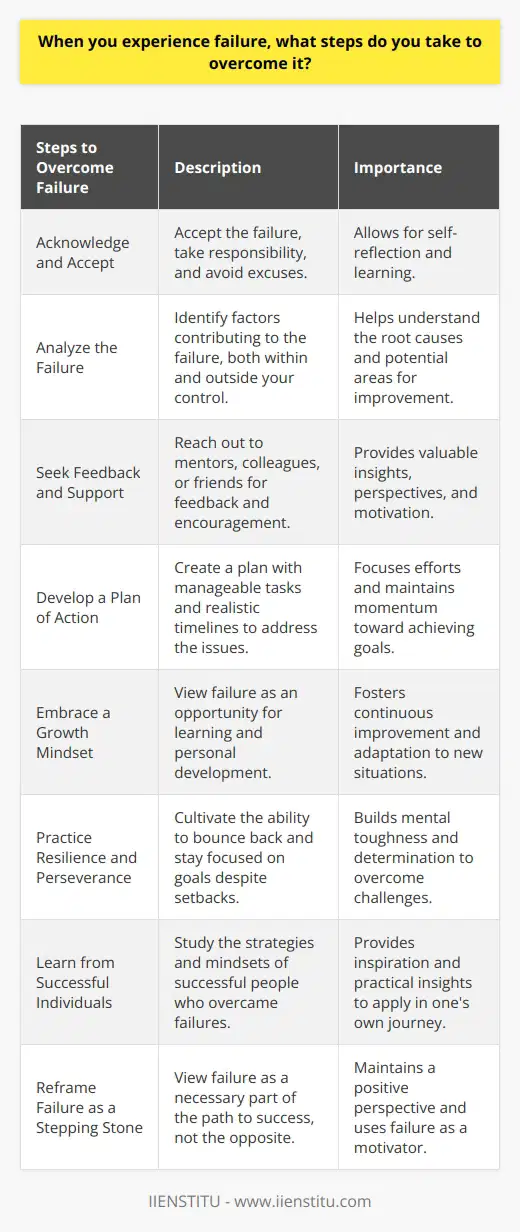
What are the most effective digital marketing strategies for increasing website traffic?
Digital marketing strategies play a crucial role in driving website traffic and attracting potential customers. To effectively increase website traffic, marketers must employ a combination of tactics that target the right audience and deliver engaging content. This paragraph explores the most effective digital marketing strategies for boosting website traffic.
Search Engine Optimization (SEO)
SEO is a fundamental strategy for increasing website traffic. It involves optimizing website content and structure to rank higher in search engine results pages (SERPs). By conducting keyword research and incorporating relevant keywords into website content, meta tags, and URLs, marketers can improve their website's visibility and attract organic traffic.
On-page SEO
On-page SEO focuses on optimizing individual web pages to rank higher in search results. This includes optimizing page titles, headings, content, and internal linking structure. By creating high-quality, relevant content that addresses user needs and incorporates targeted keywords, websites can improve their search engine rankings and attract more organic traffic.
Off-page SEO
Off-page SEO refers to activities performed outside of a website to improve its search engine rankings. This primarily involves building high-quality backlinks from reputable websites. Backlinks act as votes of confidence, signaling to search engines that a website is valuable and trustworthy. Marketers can acquire backlinks through guest blogging, broken link building, and creating shareable content.
Content Marketing
Content marketing is a powerful strategy for attracting and engaging website visitors. By creating valuable, informative, and entertaining content, marketers can establish their website as an authoritative resource in their industry. This can include blog posts, articles, infographics, videos, and podcasts that address the needs and interests of the target audience.
Blogging
Blogging is a core component of content marketing. By regularly publishing high-quality blog posts that provide value to readers, websites can attract a steady stream of organic traffic. Blog posts should be optimized for search engines, incorporating relevant keywords and internal links to other pages on the website.
Guest Posting
Guest posting involves writing content for other websites in exchange for a backlink to your own site. This strategy can help expose your website to a new audience and drive referral traffic. When guest posting, it's important to choose reputable websites in your industry and create high-quality content that provides value to their readers.
Social Media Marketing
Social media marketing can help drive website traffic by promoting content and engaging with potential customers. By sharing blog posts, articles, and other website content on social media platforms like Facebook, Twitter, and LinkedIn, marketers can expand their reach and attract new visitors to their site.
Paid Social Media Advertising
Paid social media advertising allows marketers to target specific audiences based on demographics, interests, and behaviors. By creating compelling ad copy and visuals, marketers can drive targeted traffic to their website and improve conversion rates. Platforms like Facebook Ads and LinkedIn Ads offer robust targeting options and analytics to measure campaign performance.
Email Marketing
Email marketing is a direct way to reach potential customers and drive website traffic. By building an email list of subscribers interested in your content or products, you can promote new blog posts, offer exclusive content, and encourage website visits. Email newsletters can also help keep your website top-of-mind and foster long-term relationships with your audience.
In conclusion, increasing website traffic requires a multi-faceted approach that combines SEO, content marketing, social media marketing, and email marketing. By creating high-quality, relevant content, optimizing for search engines, and promoting content through various channels, marketers can attract a steady stream of targeted traffic to their website and ultimately drive business growth.
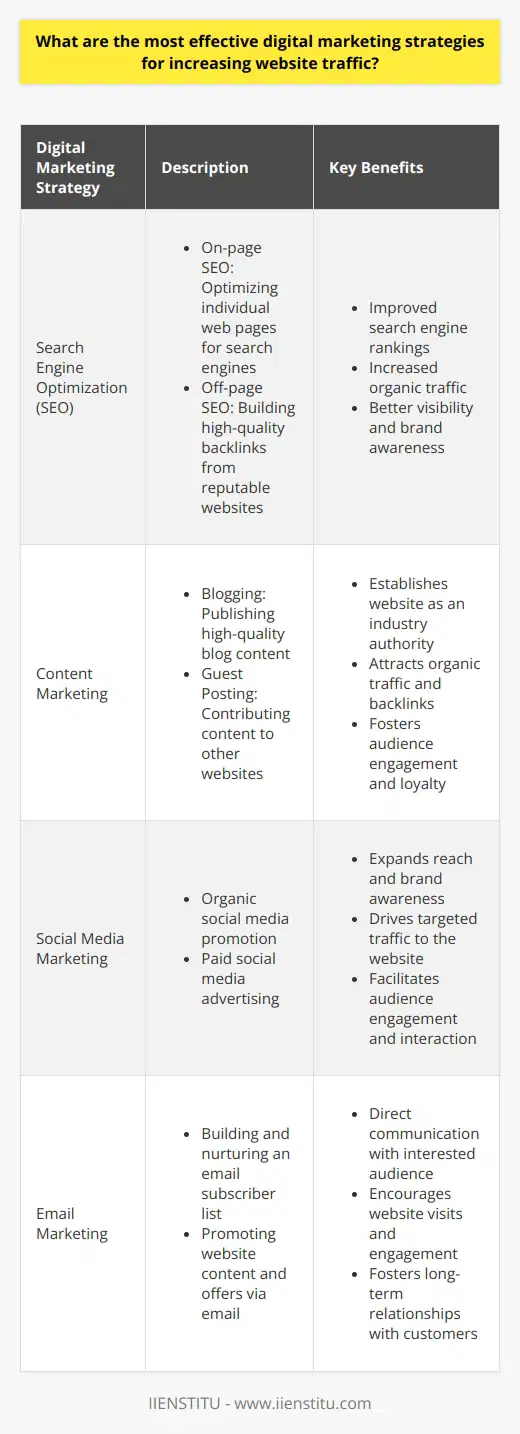
How do you measure the success of a digital marketing campaign?
Measuring the success of a digital marketing campaign involves analyzing various metrics and key performance indicators (KPIs). These metrics help determine whether the campaign's objectives have been met and identify areas for improvement. The specific KPIs used will depend on the goals of the campaign, which may include increasing brand awareness, generating leads, or driving sales.
Website Traffic
One important metric to consider is website traffic. This includes the number of unique visitors, page views, and bounce rate. An increase in website traffic during the campaign period indicates that the marketing efforts are successfully driving people to the site. However, it's crucial to analyze the quality of the traffic as well, ensuring that visitors are engaging with the content and taking desired actions.
Engagement Metrics
Engagement metrics provide insights into how users interact with the campaign's content. These metrics include clicks, likes, shares, comments, and time spent on the website. High engagement rates suggest that the content resonates with the target audience and encourages them to take action. Monitoring engagement metrics helps identify the most effective content formats and channels for the campaign.
Click-Through Rate (CTR)
The click-through rate measures the percentage of people who click on a link in an advertisement or email. A high CTR indicates that the ad or email content is compelling and relevant to the target audience. Tracking CTR helps optimize ad copy, visuals, and targeting to improve campaign performance.
Conversion Rate
The conversion rate is the percentage of visitors who complete a desired action, such as filling out a form or making a purchase. This metric directly ties to the campaign's goals and measures its effectiveness in driving tangible results. Monitoring the conversion rate helps identify any barriers in the user journey and opportunities for improvement.
Cost Per Acquisition (CPA)
The cost per acquisition measures the average cost of acquiring a new customer or lead through the campaign. Calculating CPA involves dividing the total campaign spend by the number of conversions. Tracking CPA helps evaluate the campaign's return on investment (ROI) and make data-driven decisions for budget allocation.
Return on Investment (ROI)
ROI measures the overall profitability of the digital marketing campaign. It compares the revenue generated from the campaign to the total investment made. A positive ROI indicates that the campaign is generating more revenue than its cost, while a negative ROI suggests the need for optimization or reevaluation of the campaign strategy.
Attribution Modeling
Attribution modeling helps determine which touchpoints in the customer journey contribute to conversions. By analyzing the impact of different channels and campaigns, marketers can allocate resources more effectively and optimize their overall digital marketing strategy.
To measure the success of a digital marketing campaign accurately, it's essential to set clear goals and track relevant metrics consistently. Regular monitoring and analysis of these KPIs enable marketers to make data-driven decisions, optimize campaigns in real-time, and maximize the return on their marketing investments.

What are some common challenges faced in digital marketing, and how can they be overcome?
Digital marketing presents several challenges that businesses must navigate to achieve their marketing goals effectively. One significant challenge is the constantly evolving digital landscape, which requires marketers to stay up-to-date with the latest trends and technologies. To overcome this, marketers should invest in continuous learning and professional development to acquire new skills and knowledge. Another common challenge is measuring the ROI of digital marketing efforts, as it can be difficult to attribute conversions and sales to specific campaigns. Implementing comprehensive tracking and analytics tools can help marketers gain insights into the effectiveness of their strategies and make data-driven decisions.
Targeting the Right Audience
Identifying and targeting the right audience is crucial for the success of digital marketing campaigns. With the vast amount of data available, marketers may struggle to segment their audience effectively. To address this challenge, businesses should conduct thorough market research to understand their target audience's demographics, preferences, and behaviors. By creating detailed buyer personas, marketers can tailor their messaging and content to resonate with their desired audience. Additionally, leveraging advanced targeting options offered by various digital platforms can help reach the right people at the right time.
Creating Engaging Content
Developing compelling and engaging content is another challenge faced by digital marketers. In a crowded digital space, capturing the attention of the target audience requires creating content that is informative, entertaining, and valuable. To overcome this challenge, marketers should focus on understanding their audience's needs and preferences and create content that addresses their pain points and interests. Incorporating a mix of content formats, such as blog posts, videos, infographics, and interactive elements, can help keep the audience engaged and interested. Consistently delivering high-quality content can establish the brand as a thought leader and foster long-term relationships with the audience.
Adapting to Algorithm Changes
Digital platforms, such as search engines and social media networks, frequently update their algorithms, which can impact the visibility and reach of digital marketing efforts. To stay ahead of algorithm changes, marketers should focus on creating high-quality, relevant content that adheres to the platform's guidelines and best practices. Keeping abreast of algorithm updates and adjusting strategies accordingly is essential to maintain a strong online presence. Building a diverse marketing mix that includes various channels and tactics can also help mitigate the impact of algorithm changes on overall marketing performance.
Managing Budget and Resources
Allocating budget and resources effectively is a common challenge in digital marketing. With numerous channels and tactics available, marketers may struggle to determine the most efficient use of their budget. To overcome this challenge, businesses should set clear marketing objectives and prioritize initiatives that align with their goals. Conducting a thorough analysis of past campaign performance can provide insights into which channels and tactics yield the best results, allowing marketers to optimize their budget allocation. Additionally, regularly monitoring and adjusting campaigns based on performance data can help ensure that resources are being used effectively and efficiently.
Staying Ahead of the Competition
In the fast-paced world of digital marketing, staying ahead of the competition is a constant challenge. To gain a competitive edge, businesses should regularly monitor their competitors' digital marketing efforts and identify opportunities for differentiation. Conducting a competitive analysis can provide insights into the strategies and tactics employed by competitors, allowing marketers to adapt and innovate their own approaches. Focusing on delivering exceptional customer experiences and building strong brand loyalty can also help businesses stand out in a crowded market.
Conclusion
Digital marketing presents a range of challenges, from targeting the right audience to adapting to algorithm changes and managing budgets effectively. By staying informed, creating engaging content, leveraging data-driven insights, and continuously optimizing strategies, businesses can overcome these challenges and achieve their digital marketing goals. Embracing a proactive and agile approach to digital marketing is essential for long-term success in the ever-evolving digital landscape.
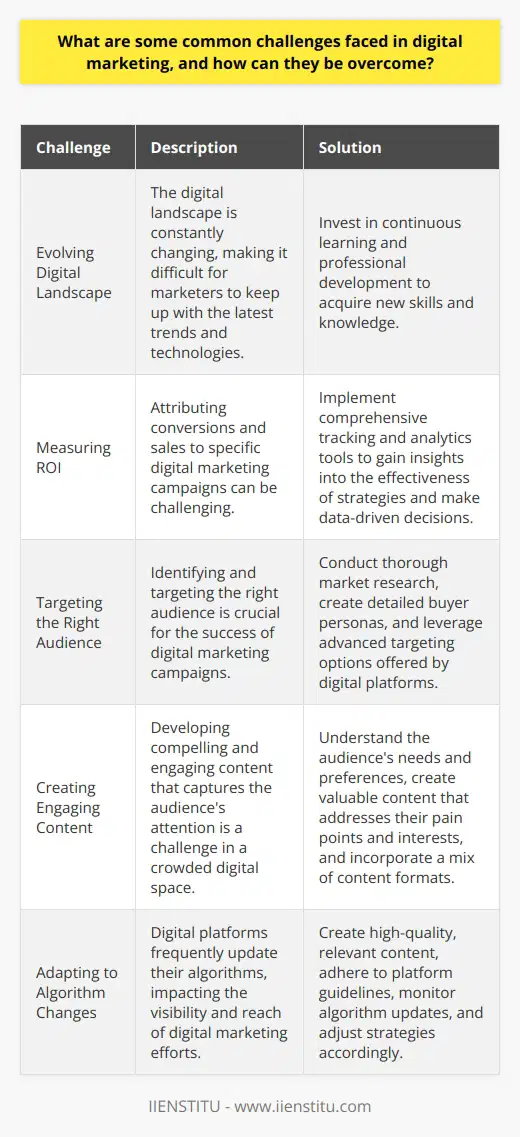
How have you handled setbacks or challenges in your previous work experiences?
Handling setbacks and challenges in previous work experiences requires a proactive approach and a growth mindset. One effective strategy is to view setbacks as opportunities for learning and improvement. By analyzing the situation objectively and identifying areas for growth, you can develop a plan to overcome the challenge and prevent similar issues from arising in the future.
Communication and Collaboration
When faced with a setback, it is crucial to communicate openly with your team and stakeholders. Sharing your concerns and seeking guidance from experienced colleagues can provide valuable insights and support. Collaborating with others to brainstorm solutions and develop a plan of action can help you navigate the challenge more effectively.
Example: Project Deadline Missed
In a previous role, my team missed a critical project deadline due to unforeseen complications. I took the initiative to schedule a meeting with the team and project stakeholders to discuss the situation transparently. Together, we identified the root causes of the delay and developed a revised timeline and resource allocation plan to get the project back on track.
Adaptability and Resilience
Demonstrating adaptability and resilience in the face of setbacks is essential for professional growth. Embracing change and being open to alternative approaches can help you overcome obstacles more efficiently. When faced with a challenge, it is important to maintain a positive attitude and focus on finding solutions rather than dwelling on the problem.
Example: Budget Constraints
In a previous position, I encountered a situation where budget constraints threatened the viability of a project. Rather than becoming discouraged, I took a proactive approach and researched alternative solutions. By negotiating with vendors, optimizing resources, and prioritizing essential features, I was able to deliver the project successfully within the revised budget.
Continuous Learning and Improvement
Setbacks and challenges provide valuable opportunities for learning and professional development. By reflecting on the experience and identifying areas for improvement, you can enhance your skills and knowledge. Seeking feedback from colleagues and mentors can also help you gain new perspectives and insights.
Example: New Technology Implementation
In a previous role, I was tasked with implementing a new technology system that I had limited experience with. Rather than becoming overwhelmed, I proactively sought out resources and training opportunities to expand my knowledge. I collaborated with experienced team members and attended workshops to gain the necessary skills. As a result, I successfully implemented the new system and improved my technical proficiency.
Conclusion
Handling setbacks and challenges in work experiences requires a combination of communication, adaptability, resilience, and a commitment to continuous learning. By approaching challenges with a growth mindset and collaborating with others, you can overcome obstacles and achieve success in your professional endeavors.
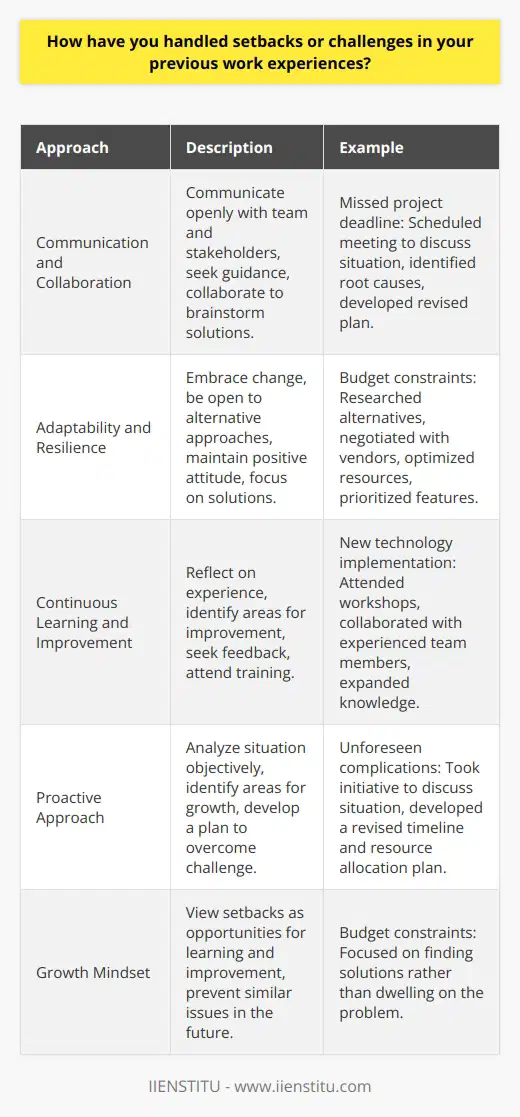
What strategies do you employ to overcome obstacles and maintain productivity in the face of setbacks at work?
Overcoming obstacles and maintaining productivity in the face of setbacks at work require a combination of strategies. These strategies involve developing a positive mindset, cultivating resilience, and implementing practical solutions to address challenges. By employing these approaches, individuals can navigate through difficulties and continue to make progress in their professional endeavors.
Cultivating a Positive Mindset
Adopting a positive mindset is crucial when facing setbacks at work. It helps to view obstacles as opportunities for growth and learning. Instead of dwelling on the negative aspects, focus on the potential benefits that can arise from overcoming the challenge. Maintain an optimistic outlook and believe in your ability to find solutions.
Reframing Negative Thoughts
When faced with a setback, it's easy to fall into negative thought patterns. Reframe these thoughts by challenging their validity and replacing them with more constructive alternatives. For example, instead of thinking, "I'll never be able to solve this problem," try, "This is a challenging situation, but I have the skills to find a solution."
Practicing Gratitude
Expressing gratitude for the positive aspects of your work and life can help maintain a positive outlook. Take a moment to reflect on the things you appreciate, such as supportive colleagues, meaningful projects, or personal growth opportunities. Regularly acknowledging these positives can boost your motivation and resilience.
Building Resilience
Resilience is the ability to bounce back from setbacks and adapt to changing circumstances. Building resilience is essential for maintaining productivity and overcoming obstacles at work. It involves developing a strong sense of self-efficacy, fostering supportive relationships, and practicing self-care.
Developing a Growth Mindset
Embrace a growth mindset, which views challenges as opportunities for development and improvement. Recognize that setbacks are temporary and that you have the capacity to learn and grow from them. Continuously seek out opportunities to enhance your skills and knowledge, as this will increase your confidence in tackling future obstacles.
Seeking Support
Don't hesitate to reach out to colleagues, mentors, or supervisors for support when facing setbacks. Collaborating with others can provide fresh perspectives, ideas, and encouragement. Building a strong network of supportive individuals can help you navigate challenges more effectively and maintain a sense of connection and motivation.
Implementing Practical Solutions
When confronted with obstacles at work, it's important to take proactive steps to address them. This involves breaking down the problem into manageable parts, developing a plan of action, and implementing practical solutions.
Breaking Down the Problem
When a setback seems overwhelming, break it down into smaller, more manageable components. Identify the specific challenges and prioritize them based on their importance and urgency. By tackling the problem piece by piece, you can make steady progress and avoid feeling overwhelmed.
Creating an Action Plan
Develop a clear action plan that outlines the steps you will take to overcome the obstacle. Set specific, measurable, achievable, relevant, and time-bound (SMART) goals to guide your efforts. Break down each goal into smaller tasks and allocate resources accordingly. Having a structured plan provides a roadmap for moving forward and helps maintain focus and motivation.
Leveraging Available Resources
Identify and utilize the resources available to you when facing setbacks. These may include training programs, mentorship opportunities, or specialized tools and technologies. Seek out guidance from experts in your field and explore best practices that can help you overcome the specific challenges you are facing.
By employing these strategies consistently, you can cultivate resilience, maintain a positive outlook, and find practical solutions to overcome obstacles at work. Remember that setbacks are a natural part of the professional journey, and each challenge presents an opportunity for growth and learning. Stay focused on your goals, seek support when needed, and trust in your ability to navigate through difficult times. With persistence and a proactive approach, you can maintain productivity and achieve success in the face of adversity.
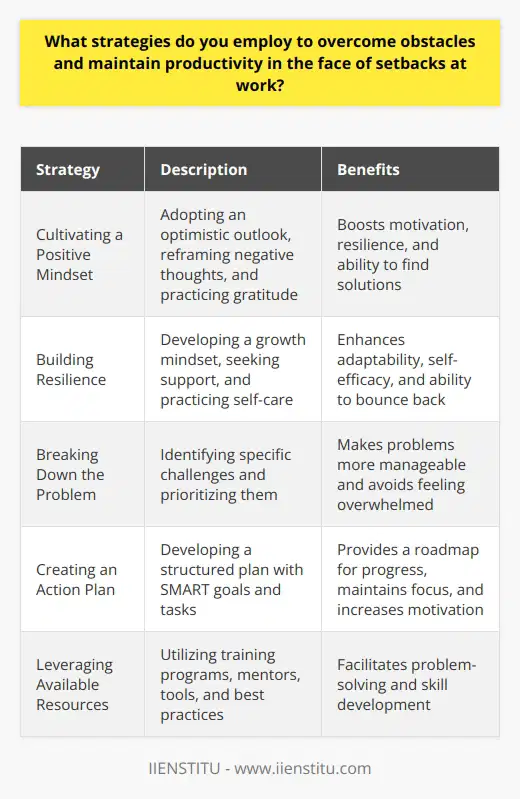
Can you describe a specific instance where you encountered a setback at work and how you successfully navigated through it?
Navigating setbacks at work is a crucial skill for professional growth and success. One specific instance where I encountered a significant setback was during a critical project deadline. Our team faced unexpected technical issues that threatened to derail our progress and jeopardize the timely delivery of the project.
Assessing the Situation
Upon realizing the severity of the setback, I quickly gathered the team to assess the situation. We identified the root cause of the technical problems and brainstormed potential solutions. It was essential to maintain a calm and focused approach to prevent panic from spreading among team members.
Developing a Plan of Action
Together with the team, we developed a comprehensive plan of action to address the setback. We prioritized tasks based on their impact on the project's timeline and allocated resources accordingly. Clear communication and collaboration were key to ensuring everyone was on the same page and working towards a common goal.
Implementing Solutions
We divided the team into smaller groups, each focusing on specific aspects of the problem. Regular check-ins and progress updates helped maintain accountability and identify any new challenges that arose. By breaking down the setback into manageable components, we were able to tackle each issue systematically and efficiently.
Leveraging External Resources
Recognizing the limitations of our internal expertise, we reached out to external resources for assistance. We consulted with technical experts and sought guidance from colleagues who had faced similar setbacks in the past. Their insights and recommendations proved invaluable in overcoming the obstacles we encountered.
Maintaining Team Morale
Throughout the setback, I made a conscious effort to maintain team morale and motivation. I acknowledged the hard work and dedication of each team member and encouraged open communication. Celebrating small victories along the way helped keep everyone engaged and focused on the end goal.
Learning from the Experience
Once we successfully navigated through the setback and delivered the project, we conducted a thorough post-mortem analysis. We identified the lessons learned and discussed ways to prevent similar setbacks in the future. This experience taught us the importance of contingency planning, effective communication, and adaptability in the face of adversity.
Conclusion
Encountering setbacks at work is inevitable, but it is how we respond to them that defines our success. By assessing the situation objectively, developing a plan of action, leveraging external resources, and maintaining team morale, we can effectively navigate through challenges and emerge stronger as professionals.
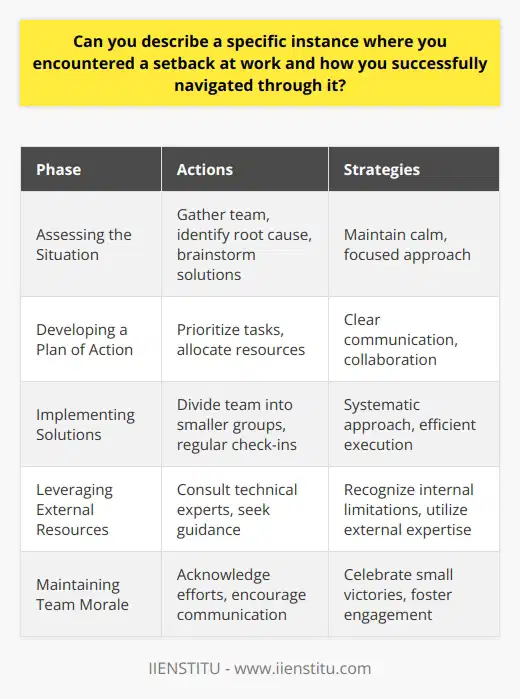
What are the most common digital marketing interview questions and their answers in PDF format?
Digital marketing interviews often cover a range of topics, from basic concepts to more advanced strategies and techniques. Some of the most common questions asked in these interviews include:
Understanding of Digital Marketing Fundamentals
Interviewers want to assess the candidate's knowledge of digital marketing principles, such as SEO, PPC, social media, and email marketing. They may ask the applicant to define these terms and explain how they work together in a digital marketing strategy.
Example questions:
What is SEO, and how does it help a business grow online?
Explain the difference between organic and paid search results.
What are the key components of a successful social media marketing campaign?
Experience with Digital Marketing Tools and Platforms
Candidates should be familiar with popular digital marketing tools and platforms, such as Google Analytics, Google Ads, and social media management tools. Interviewers may ask about the applicant's experience using these tools and how they have leveraged them to achieve marketing goals.
Example questions:
What metrics do you track in Google Analytics, and why are they important?
How do you optimize a Google Ads campaign for better performance?
What social media management tools have you used, and how do they streamline your workflow?
Problem-Solving and Analytical Skills
Digital marketing requires strong problem-solving and analytical skills to identify challenges, develop solutions, and measure results. Interviewers may present hypothetical scenarios or ask about past experiences to gauge the candidate's ability to think critically and make data-driven decisions.
Example questions:
How would you improve a website's conversion rate?
Describe a time when you used data to optimize a marketing campaign.
What steps would you take to address a sudden drop in organic traffic?
Staying Up-to-Date with Industry Trends
The digital marketing landscape is constantly evolving, and successful professionals must stay informed about the latest trends and best practices. Interviewers may ask candidates how they stay current with industry developments and how they apply new knowledge to their work.
Example questions:
What resources do you use to stay informed about digital marketing trends?
How do you determine which new marketing strategies or technologies to adopt?
Describe a recent industry trend and how it has influenced your marketing approach.
By preparing for these common digital marketing interview questions, candidates can demonstrate their expertise, problem-solving abilities, and commitment to staying current in the field. Providing clear, concise answers with relevant examples can help applicants stand out and secure the desired position.

Where can I find a comprehensive PDF guide on digital marketing interview questions and answers?
Finding a comprehensive PDF guide on digital marketing interview questions and answers is possible through various online resources. Websites such as LinkedIn, Glassdoor, and Indeed offer valuable insights into common interview questions and potential responses. Additionally, many digital marketing blogs and websites provide free downloadable PDF guides that cover a wide range of topics related to digital marketing interviews.
Utilizing Professional Networking Platforms
Professional networking platforms like LinkedIn are excellent sources for discovering interview preparation materials. Many experienced digital marketers share their knowledge and experiences through articles, posts, and discussions. These platforms also host groups dedicated to digital marketing, where members often share resources, including PDF guides on interview questions and answers.
Searching for Industry-Specific Websites
Industry-specific websites, such as HubSpot, Moz, and Search Engine Journal, frequently publish content related to digital marketing careers. These websites often have dedicated sections or blog posts that focus on interview preparation. They may offer downloadable PDF guides or link to external resources that provide comprehensive lists of digital marketing interview questions and suggested answers.
Exploring Online Learning Platforms
Online learning platforms, such as Coursera, Udemy, and Skillshare, offer courses on various aspects of digital marketing. Some of these courses include modules or resources that specifically address interview preparation. These resources may include PDF guides, video tutorials, or interactive quizzes that help you prepare for digital marketing interviews.
Consulting Digital Marketing Agencies
Digital marketing agencies often have blogs or resource sections on their websites that provide valuable content for aspiring digital marketers. These resources may include PDF guides on interview questions and answers, as well as tips and tricks for acing digital marketing interviews. Some agencies may even offer free downloadable resources in exchange for signing up for their newsletters or following their social media accounts.
Reaching Out to Digital Marketing Professionals
Connecting with experienced digital marketing professionals can be a great way to access interview preparation resources. You can reach out to them through professional networking platforms, attend industry events, or join online communities. Many professionals are willing to share their knowledge and may have PDF guides or other resources that they can share with you.
Conducting Targeted Google Searches
Conducting targeted Google searches using keywords such as "digital marketing interview questions PDF" or "digital marketing interview guide" can yield relevant results. Be sure to filter your search results by file type (PDF) to narrow down the results. You may find blog posts, articles, or forums that link to comprehensive PDF guides on digital marketing interview questions and answers.
In conclusion, finding a comprehensive PDF guide on digital marketing interview questions and answers requires a combination of strategies. Utilize professional networking platforms, explore industry-specific websites, and consult online learning platforms. Additionally, reaching out to digital marketing professionals and conducting targeted Google searches can lead you to valuable resources that will help you prepare for your digital marketing interviews.

Can you recommend a reliable source for a PDF containing digital marketing interview questions and answers?
Recommending a reliable source for a PDF containing digital marketing interview questions and answers requires careful consideration. Several factors should be taken into account when evaluating the credibility and usefulness of such a resource. This paragraph will explore the key aspects to consider when seeking a trustworthy PDF for digital marketing interview preparation.
Authority and Expertise
First, it is crucial to assess the authority and expertise of the individual or organization providing the PDF. Look for resources created by recognized industry experts, digital marketing professionals, or reputable educational institutions. These sources are more likely to offer accurate and up-to-date information based on their knowledge and experience in the field.
Relevance and Comprehensiveness
The PDF should cover a wide range of digital marketing topics relevant to the current industry landscape. It should include questions and answers related to various aspects of digital marketing, such as search engine optimization (SEO), pay-per-click (PPC) advertising, social media marketing, content marketing, and email marketing. A comprehensive resource will better prepare you for the diverse range of questions you may encounter during an interview.
Clarity and Organization
The PDF should be well-structured and easy to navigate. Look for a resource that organizes questions and answers in a logical manner, possibly categorized by topic or difficulty level. Clear formatting, such as the use of headings, subheadings, and bullet points, can enhance readability and make it easier to locate specific information quickly.
User Reviews and Recommendations
Reading user reviews and seeking recommendations from professionals in the digital marketing community can provide valuable insights. Look for feedback from individuals who have used the PDF and found it helpful in their interview preparation. Positive reviews and endorsements from trusted sources can indicate the quality and effectiveness of the resource.
Regular Updates
Digital marketing is a rapidly evolving field, with new trends, technologies, and best practices emerging regularly. It is essential to choose a PDF that is regularly updated to reflect the latest industry developments. An outdated resource may not adequately prepare you for questions related to current digital marketing strategies and tools.
Reputable Websites and Platforms
Consider downloading the PDF from reputable websites or platforms specializing in digital marketing resources. Websites such as HubSpot, Moz, or Digital Marketing Institute are known for providing high-quality content and educational materials. Additionally, professional networking platforms like LinkedIn may have groups or forums where digital marketers share recommended resources, including interview question PDFs.
In conclusion, finding a reliable source for a PDF containing digital marketing interview questions and answers requires careful evaluation. Look for resources created by industry experts, ensure the content is relevant and comprehensive, and prioritize clarity and organization. User reviews and recommendations can provide valuable insights, and regular updates ensure the information remains current. By considering these factors and exploring reputable websites and platforms, you can increase your chances of finding a trustworthy PDF to aid in your digital marketing interview preparation.

What are your strengths and weaknesses?
Self-awareness is crucial for personal growth and development. Recognizing one's strengths and weaknesses allows for targeted improvement and informed decision-making. My strengths include strong analytical skills, adaptability, and effective communication. I excel at breaking down complex problems and finding innovative solutions. Additionally, I adapt well to new situations and challenges, maintaining a positive attitude and open mind. I also communicate clearly and concisely, ensuring that my ideas are understood by others.
Weaknesses and Areas for Improvement
However, I also acknowledge my weaknesses and areas that require improvement. I sometimes struggle with time management, particularly when faced with multiple competing priorities. I need to enhance my ability to prioritize tasks effectively and allocate my time efficiently. Moreover, I can be overly self-critical at times, focusing too much on perfection rather than progress. I am working on embracing constructive feedback and celebrating small victories along the way.
Strategies for Addressing Weaknesses
To address my weaknesses, I am actively implementing strategies and seeking opportunities for growth. I am learning to break down larger tasks into manageable steps and set realistic deadlines. I also use productivity tools and techniques to stay organized and focused. Additionally, I am practicing self-compassion and reframing my mindset to view challenges as opportunities for learning and development. I actively seek feedback from others and use it to guide my personal and professional growth.
Leveraging Strengths for Success
While addressing weaknesses is important, it is equally crucial to leverage one's strengths for success. I aim to apply my analytical skills to solve complex problems and drive innovation in my work. I embrace change and adapt quickly to new environments, allowing me to thrive in dynamic situations. Furthermore, I use my communication skills to collaborate effectively with others, build strong relationships, and convey ideas with clarity and impact.
Continuous Learning and Growth
Ultimately, recognizing one's strengths and weaknesses is an ongoing process of self-discovery and growth. I am committed to continuous learning and development, seeking out new challenges and opportunities to expand my skills and knowledge. By embracing my strengths, addressing my weaknesses, and maintaining a growth mindset, I strive to reach my full potential and make a positive impact in my personal and professional life.
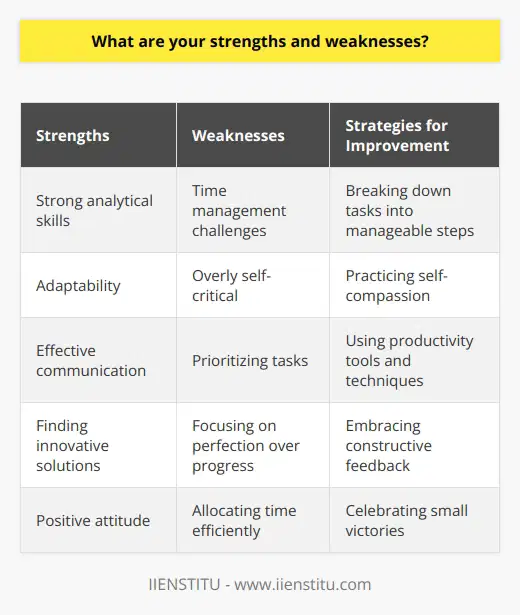
How do you stay up-to-date with the latest digital marketing trends and techniques?
Staying up-to-date with the latest digital marketing trends and techniques is crucial for marketers in today's fast-paced digital landscape. One effective way to stay informed is by regularly reading industry blogs and publications. These resources offer valuable insights into emerging trends, best practices, and case studies. Additionally, attending digital marketing conferences and webinars provides opportunities to learn from experts and network with peers. Social media platforms, such as LinkedIn and Twitter, are also excellent sources of information, as industry leaders often share their knowledge and engage in discussions. Furthermore, experimenting with new tools and platforms allows marketers to gain hands-on experience and stay ahead of the curve. By dedicating time to continuous learning and actively seeking out new information, digital marketers can ensure they remain competitive and deliver effective strategies for their clients or organizations.
Read Industry Blogs and Publications
Industry blogs and publications are excellent resources for staying informed about the latest digital marketing trends and techniques. These sources provide in-depth articles, case studies, and expert opinions on various topics related to digital marketing. By regularly reading these materials, marketers can gain valuable insights into emerging trends, best practices, and successful strategies employed by other professionals in the field. Some popular industry blogs and publications include Search Engine Journal, Marketing Land, and Social Media Examiner. Subscribing to these resources and setting aside time to read them consistently can help marketers stay up-to-date and inspired.
Attend Digital Marketing Conferences and Webinars
Digital marketing conferences and webinars offer unique opportunities to learn from industry experts and network with peers. These events bring together professionals from various backgrounds to share their knowledge, experiences, and insights. Attendees can participate in workshops, panel discussions, and keynote presentations that cover a wide range of digital marketing topics. By attending these events, marketers can gain exposure to new ideas, strategies, and tools that can enhance their skills and inspire creative solutions. Additionally, networking with other professionals can lead to valuable connections, collaborations, and learning opportunities.
Leverage Social Media Platforms
Social media platforms, such as LinkedIn and Twitter, have become essential tools for staying up-to-date with digital marketing trends and techniques. Industry leaders, influencers, and brands often share their knowledge, opinions, and experiences on these platforms, making them valuable sources of information. By following relevant hashtags, joining industry-specific groups, and engaging in discussions, marketers can access a wealth of knowledge and stay connected with the pulse of the industry. Social media also allows marketers to share their own insights, ask questions, and build relationships with other professionals in the field.
Experiment with New Tools and Platforms
Hands-on experience is crucial for staying up-to-date with the latest digital marketing trends and techniques. By experimenting with new tools and platforms, marketers can gain practical knowledge and develop a deeper understanding of how these technologies work. This experimentation can involve testing new social media features, exploring emerging ad platforms, or implementing innovative content formats. By actively engaging with these tools and platforms, marketers can assess their potential, identify best practices, and adapt their strategies accordingly. Experimenting also fosters a culture of continuous learning and innovation, which is essential for staying ahead in the ever-evolving digital marketing landscape.
Dedicate Time to Continuous Learning
To stay up-to-date with the latest digital marketing trends and techniques, it is essential to dedicate time to continuous learning. This involves setting aside regular time slots for reading, researching, and exploring new ideas. By prioritizing learning and making it a consistent part of their routine, marketers can ensure they are always expanding their knowledge and skills. Continuous learning can take various forms, such as enrolling in online courses, participating in workshops, or joining professional development programs. By investing in their own growth and development, marketers can stay competitive, adapt to changing market conditions, and deliver more value to their clients or organizations.
Conclusion
Staying up-to-date with the latest digital marketing trends and techniques is an ongoing process that requires dedication and effort. By leveraging industry blogs and publications, attending conferences and webinars, utilizing social media platforms, experimenting with new tools, and prioritizing continuous learning, marketers can ensure they remain informed and competitive in the ever-evolving digital landscape. By consistently seeking out new knowledge and applying it to their work, digital marketers can deliver innovative and effective strategies that drive results for their clients or organizations.
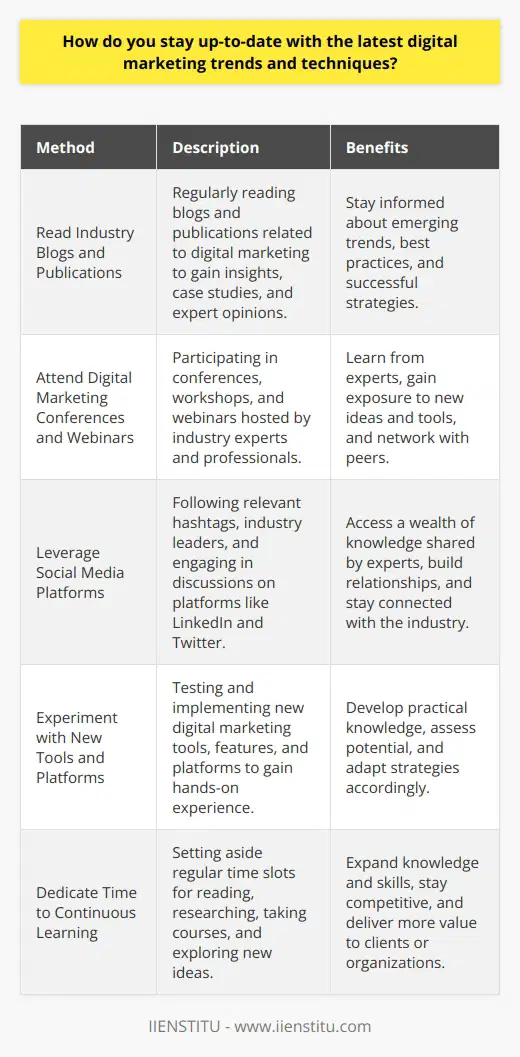
Can you describe a successful digital marketing campaign you have worked on and what made it effective?
One successful digital marketing campaign I worked on involved promoting a new product launch for a beauty brand. The campaign's effectiveness stemmed from a multi-faceted approach that leveraged various digital channels to reach the target audience. By conducting thorough market research, we identified the key demographics and preferences of potential customers, which informed our strategy.
Targeted Social Media Advertising
We created a series of engaging social media ads tailored to the interests and behaviors of our target audience. These ads featured eye-catching visuals, compelling copy, and clear calls-to-action, encouraging users to learn more about the product. By utilizing advanced targeting options on platforms like Facebook and Instagram, we ensured that our ads reached the most relevant individuals, maximizing their impact.
Influencer Partnerships
To further amplify our message and build trust, we collaborated with influential beauty bloggers and social media personalities. These influencers created authentic, informative content showcasing the product's benefits and demonstrating its use in real-life scenarios. Their endorsements helped generate buzz and credibility among their dedicated follower bases, driving increased interest and engagement.
Interactive Landing Page
We developed a visually stunning, user-friendly landing page that served as the central hub for the campaign. The page provided detailed information about the product, including its key features, benefits, and customer testimonials. Interactive elements, such as a virtual try-on tool and a shade finder, allowed visitors to engage with the product and visualize how it would work for them, enhancing their overall experience.
Email Marketing
To nurture leads and encourage conversions, we implemented a strategic email marketing campaign. We segmented our email list based on user behavior and preferences, allowing us to deliver highly personalized content. From exclusive launch offers to educational tutorials and product recommendations, our emails provided value to subscribers while subtly guiding them towards making a purchase.
Measurable Results
Throughout the campaign, we closely monitored key performance indicators (KPIs) to assess its effectiveness and make data-driven optimizations. By tracking metrics such as click-through rates, conversion rates, and revenue generated, we were able to continually refine our approach and allocate resources to the most successful tactics. This iterative process allowed us to maximize the campaign's ROI and achieve significant growth in product sales and brand awareness.
Conclusion
The success of this digital marketing campaign can be attributed to several factors. By leveraging a combination of targeted advertising, influencer partnerships, an engaging landing page, and personalized email marketing, we effectively reached and resonated with our target audience. The campaign's data-driven approach, coupled with a focus on delivering value and creating memorable experiences, ultimately drove impressive results for the beauty brand.
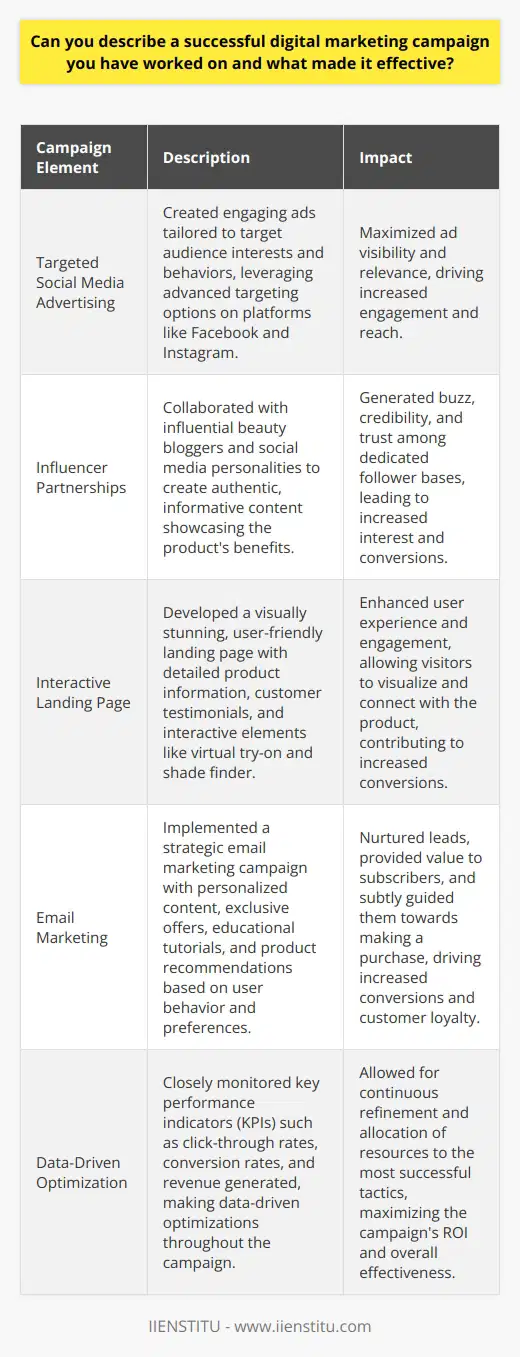
How do you typically respond when faced with failure or success in your professional life?
In the face of professional failure or success, individuals often respond in diverse ways that reflect their unique personalities, experiences, and coping mechanisms. Some may view failure as a devastating blow to their self-esteem, while others see it as an opportunity for growth and learning. Similarly, success can be met with a range of reactions, from humble gratitude to unbridled euphoria.
Responding to Failure
When confronted with failure, it is essential to maintain a positive attitude and view the experience as a chance to develop both personally and professionally. Rather than engaging in self-blame or dwelling on the negative aspects of the situation, it is more productive to analyze the factors that contributed to the failure and identify areas for improvement. By treating failure as a learning experience, individuals can cultivate resilience and adaptability, two crucial qualities for long-term success.
Strategies for Coping with Failure
Acknowledge and accept the failure without letting it define your worth as a professional.
Analyze the situation objectively to identify the root causes of the failure.
Seek feedback from colleagues, mentors, or supervisors to gain new perspectives and insights.
Develop a plan of action to address weaknesses and prevent similar failures in the future.
Responding to Success
When faced with professional success, it is important to maintain a balanced perspective and avoid becoming overconfident or complacent. While it is natural to feel a sense of pride and accomplishment, it is equally important to recognize the contributions of others and express gratitude for their support. Additionally, success should be viewed as a stepping stone rather than a final destination, as there is always room for further growth and improvement.
Strategies for Leveraging Success
Celebrate your achievements while maintaining a humble and appreciative attitude.
Acknowledge the role of teamwork and collaboration in your success.
Use the momentum generated by success to set new goals and challenge yourself further.
Share your knowledge and experience with others to foster a culture of continuous learning and improvement.
The Importance of Emotional Intelligence
Ultimately, the ability to respond effectively to both failure and success in the professional realm is closely tied to emotional intelligence. Those who possess high levels of self-awareness, self-regulation, and empathy are better equipped to navigate the complex emotions that arise in the face of setbacks and triumphs. By cultivating these skills, individuals can maintain a balanced perspective, build strong relationships with colleagues, and create a foundation for long-term success in their careers.
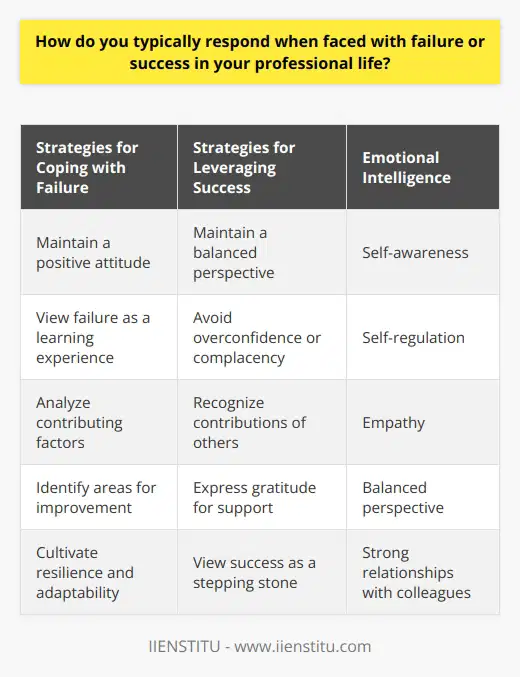
What strategies do you employ to maintain a balanced perspective when dealing with either failure or success in your career?
Maintaining a balanced perspective when dealing with either failure or success in one's career requires a multifaceted approach. One crucial strategy is to cultivate a growth mindset, which involves viewing failures as opportunities for learning and improvement. This mindset helps individuals to reframe setbacks as temporary challenges rather than defining moments. Additionally, setting realistic goals and expectations can help to prevent both the overwhelming disappointment of failure and the overinflation of ego in success.
Cultivating Resilience
Another key strategy is to develop resilience, which is the ability to bounce back from adversity. Resilience can be fostered through practicing self-care, maintaining a strong support network, and engaging in activities that promote mental and physical well-being. It is also essential to separate one's self-worth from their professional achievements or failures, recognizing that they are not defined solely by their career.
Practicing Mindfulness
Mindfulness is another powerful tool for maintaining a balanced perspective. By staying present in the moment and observing thoughts and emotions without judgment, individuals can avoid becoming overly attached to outcomes. Regular mindfulness practice, such as meditation or deep breathing exercises, can help to reduce stress and increase emotional regulation.
Seeking Feedback and Mentorship
Seeking feedback from trusted colleagues, mentors, or supervisors can provide valuable insights and help to maintain a balanced outlook. Constructive criticism can highlight areas for improvement, while positive feedback can reinforce strengths and boost confidence. Building relationships with mentors who have navigated similar challenges can also provide guidance and support during both successful and challenging times.
Celebrating Successes and Learning from Failures
It is important to acknowledge and celebrate successes, no matter how small, to maintain motivation and a positive outlook. However, it is equally crucial to avoid becoming complacent or overconfident. When faced with failure, it is essential to take the time to reflect on the experience, identify lessons learned, and use that knowledge to inform future decisions and actions.
Maintaining Work-Life Balance
Finally, maintaining a healthy work-life balance is critical for preserving a balanced perspective. Engaging in hobbies, spending time with loved ones, and prioritizing self-care can help to prevent burnout and provide a sense of fulfillment outside of work. By establishing clear boundaries between work and personal life, individuals can ensure that their identity and well-being are not entirely tied to their professional achievements or setbacks.
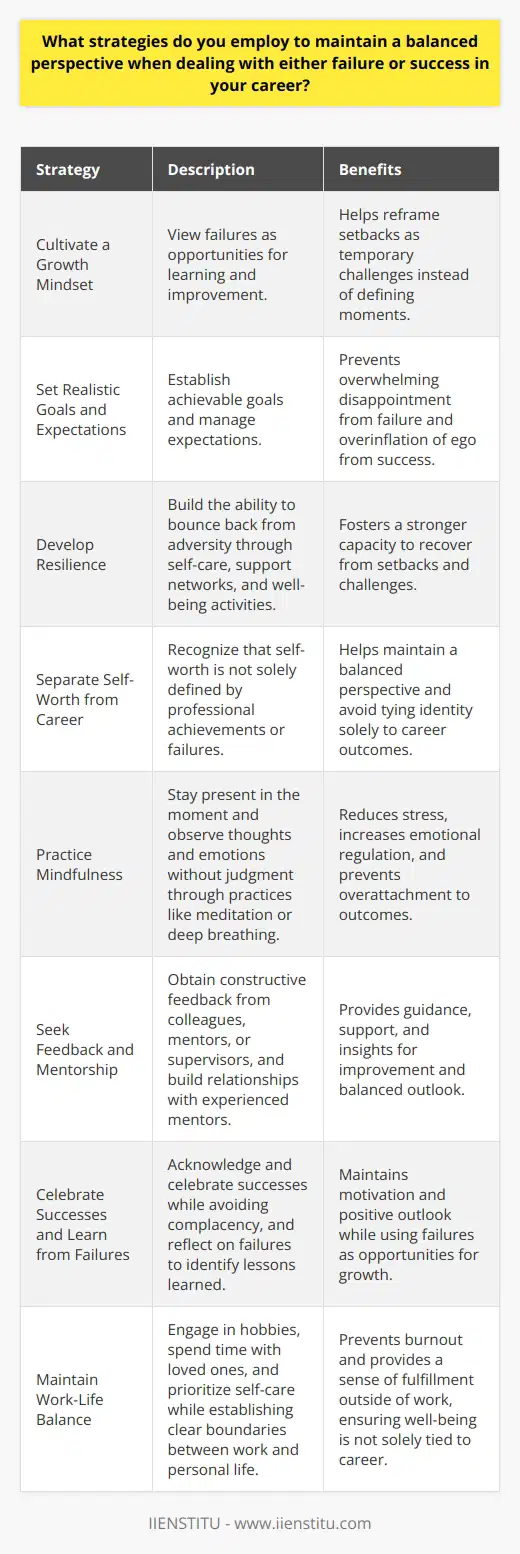
Can you describe a specific instance where you encountered failure or success and how you managed the situation in an interview setting?
In an interview setting, discussing a specific instance of failure or success requires careful consideration and preparation. When describing a failure, it is essential to focus on the lessons learned and how you grew from the experience. For example, if you led a project that missed a critical deadline, you could explain how you took responsibility, communicated transparently with stakeholders, and implemented new processes to prevent future delays.
Demonstrating Growth and Resilience
By highlighting your ability to learn from mistakes and adapt, you demonstrate growth and resilience. Employers value candidates who can handle adversity and use it as an opportunity for improvement. When discussing a success, it is important to be specific about your role and the impact of your contributions. For instance, if you implemented a new system that increased efficiency and saved the company money, you could detail the steps you took to identify the problem, develop a solution, and measure the results.
Showcasing Leadership and Initiative
By emphasizing your leadership skills and initiative, you showcase your value as a potential employee. In both cases, it is crucial to be honest and authentic in your description of the situation. Avoid exaggerating or downplaying your role, as this can undermine your credibility. Instead, focus on providing a clear and concise account of the situation, your actions, and the outcomes.
Preparing for Follow-up Questions
Be prepared for follow-up questions that may delve deeper into the situation or your decision-making process. Practice your response beforehand to ensure you can articulate your thoughts clearly and concisely. Remember, the goal is to provide a meaningful example that highlights your strengths, abilities, and potential as a candidate.
Connecting to the Job Requirements
When possible, try to choose an example that relates to the requirements of the job you are interviewing for. This helps demonstrate how your past experiences have prepared you for the role and shows the interviewer that you have given thought to how you can contribute to the organization.
By effectively communicating a specific instance of failure or success in an interview setting, you can provide valuable insight into your character, work ethic, and potential as an employee. Remember to be honest, focus on the lessons learned, and highlight your strengths and abilities throughout your response.

